Home » Ornamentals » General Ornamental Info

Travelers Palm Care: Tips On Growing Ravenala Madagascariens
Tropical plants provide some of the most interesting conversation pieces due to their vibrant colors and unique shapes.
The Travelers Palm, aka Ravenala madagascariensis (ra-VEN-ah-la mad-uh-gas-KAR-ee-EN-sis) is a perfect example of both.

Known best by the common name traveler’s palm, this fan-shaped broadleaf evergreen isn’t actually a true palm but a member of the Strelitziaceae family, aka White Bird of Paradise .
Other common names are traveler’s tree and east-west palm (in the US, the common names may have the alternate spelling of traveler’s palm or traveler’s tree).
The names refer to its use by travelers as a source of fresh water, who gather rainwater from the leaf bases and bracts.
As its scientific name suggests, this tree hails from the rainforests of Madagascar. There are four subspecies, which are generally referred to in botanical circles by their local names.
- Bemavo is the largest and most natively common variety.
- Hiranirana is found wherever breaks in the rainforest occur.
- Malama is the rarest of the four
- Horonorona is the smallest and is commonly cultivated as an ornamental perennial.
Travelers Palm Quick Care Tips
- Botanical Name: Ravenala Madagascariens
- Common Name(s): Travelers Palm
- Synonyms: None
- Family & Origin: Strelitziaceae family, native to Madagascar
- Growability: Easy to grow
- Grow Zone: 10-11
- Size: Grows up to 30 feet tall
- Flowering: Rarely flowers indoors
- Light: Bright, indirect light
- Humidity: Prefers high humidity
- Temperature: Thrives in warm temperatures, between 60-80°F
- Soil: Well-draining soil
- Water: Water regularly, keeping soil moist but not waterlogged
- Fertilizer: Fertilize every 2-3 months with a balanced fertilizer
- Pests & Diseases: Susceptible to spider mites and mealybugs, as well as root rot if overwatered
- Propagation: Propagate through division or by planting seeds
- Plant Uses: Makes a great indoor or outdoor statement plant, can also be used for privacy screening.
Agave Flower Grooming And Maintenance
Travelers palm care, traveler palm size and growth.
Horonorona , the variant most commonly cultivated, achieves an average adult height of 30 to 50’ feet tall. By comparison, its largest kin, Bemavo , may achieve a height of 100’ feet.
The central trunk of this species can measure up to 12” inches in diameter and lacks branches.
The fan comprises of a single, vertical plane of petioles ending in 20 to 30 banana-like leaves. The leaves measure 5′ to 10’ feet long and 2′ to 3’ feet wide, with the petioles matching or exceeding the leaf length.
Because of the immense width and height proportions, this is one of those South Florida “palms” that work best in more expansive landscapes and with larger homes.
The cupped bases of each leaf stalk can retain as much as a full quart of water, creating a source of drinking water for passers-by.
While young, the trunk is subterranean, leaving the fan at ground level. When it finally emerges, it sheds the lowest leaves, resulting in leaf scar rings.

These plants grow to be enormous, with huge leaves sprouting from long stems in a flat, fan-shaped pattern like a peacock’s tail.
At the base of the trunk, new shoots appear, with the leaves tightly curled up inside. Numerous suckers will sprout at different times from around the trunk’s base.
Being slow to develop, a traveler’s palm won’t flower until it’s ten years old. Once flowering begins, it will bloom mainly in summer but may produce flowers throughout the year.
The resulting seeds are edible, giving this plant quite a few practical uses.
The growth rate is fast until a trunk begins to develop. Then the plant settles into a nice, moderate pace.
Flowering and Fragrance
Travelers-tree is ideal for creating an exotic, tropical effect with its very large, banana-like leaves, each up to ten feet long and held in fan-shaped formation, and the unusual, small, creamy white flowers held erect in boat-shaped bracts.
During the summer months, the traveler’s palm produces continual white or chartreuse blooms, the nocturnal inflorescence opening every 2 to 3 days.
The exact number of open blooms will vary, with the three-petaled flowers emerging from boat-shaped spathes, giving them a similar appearance to the famous bird-of-paradise.
The leaves always grow in an east-west direction so a lost traveler can find his way. One that is – well, you decide: Stand in front and make a wish in good spirit – and the wish will come true.
This Bird of Paradise relative produces large amounts of nectar, which not only attracts pollinators but is an important food source for native lemurs.
Once fertilized, the flowers give way to 3 ½” inch wooden capsules filled with seeds covered in bright blue arils.
Light and Temperature
This tree loves a sunny spot, faring best when exposed to full sun. It can tolerate partial shade and do best when young in an area where the base stays somewhat shaded. Eventually, it will grow to a full sun height.

East-west palm has a narrower temperature tolerance and should only be grown in USDA hardiness zones 10 to 11.
Temperatures dipping below 60° degrees Fahrenheit will begin to stress the tree, and anything below 40° degrees Fahrenheit can kill it.
Watering and Feeding
The Travelers palm needs soil that remains consistently moist due to its rainforest origins. However, you should be careful not to overwater the plant.
Travelers palms need regular water – another reason to keep the base in a partly shaded area while it’s young and getting established.

Although the plant is relatively disease resistant, a well-drained planting site produces the healthiest growth.
While some variants have been known to grow in poor soil, adding a nitrogen-rich fertilizer during the growing season will result in a healthier and faster-growing tree.
Avoid adding too much fertilizer, as that can damage plants.
Plant with top soil or organic peat moss added to the hole. Fertilize 3 times a year in spring, summer, and autumn using a quality all-purpose or palm fertilizer. Trim off outside leaf branches as needed (and as long as the plant is reachable).
Soil & Transplanting
A rich, loamy soil with neutral to mild acidity works best for travelers palm plants. The soil should be able to retain some water without becoming too wet.
Brown leaves are a sign of over-fertilization and if the soil does not have good drainage.
You should only repot the plant if you see that the roots are poking through the drainage holes.

Pot the baby plant in moist, well-aerated soil, and ensure that the mother plant is properly covered back up in the soil.
A standard potting mix will do wonders for your plant. You can also include things such as compost, which will help increase drainage.
This tree doesn’t require a lot of maintenance. However, root suckers will create clusters of foliage if not removed, distorting the trademark shape of the agave flower.
How To Propagate Ravenala Madagascariensis
Traveler’s tree may be propagated by both seed and division. The quickest method is to locate rooted suckers, which grow near the main stem.

Separate these at the beginning of the rainy season and plant them to get a head start on new growth.
The seeds require a little more effort. Plant them in moist, sandy soil and keep them at around 68° degrees Fahrenheit. Germination is a slow process for this plant.
Once the seedlings have reached two months of age, they may be transplanted into a rich, loamy soil.
Make sure they have full sun, and add some moss or other organic matter when transplanting to help ensure their roots stay moist.
Travelers Palm Pest or Disease Problems
Due to the frail nature of the leaves, this plant should be sheltered from high winds. It also fares poorly in drought conditions.
Some of the diseases include the leaves of the plant turning yellow. This usually happens due to a lack of nutrients, or if you end up over-watering the plant.
The plant is non-invasive, but has been known to host Colletotrichum gloeosporioides, and is susceptible to various forms of leaf spot and root rot. Spider mites may also infest this tree.
While some parts of the Travelers Palm plant are edible, other parts are poisonous if consumed. Individuals with bee allergies should use caution around this plant, which attracts pollinators.

Suggested Uses For The Travelers Palm
Beyond the obvious visual appeal, traveler’s palm’s high nectar production attracts a wide range of pollinators. This not only includes nectar-feeding birds and insects, but some species of bat.
The bright blue seeds are edible and have a mealy consistency, while the arils have no flavor. Oil extracted from the seeds and their arils can be used for cooking and is midway between coconut butter and palm oil in composition.
Additionally, the plant’s ability to catch rainwater makes it a useful source of extra drinking water. Finally, the sap may be used to create sugar.
Parts of this plant have had a range of uses beyond the obvious ornamental value. The seed oil is considered antiseptic, while the leaves have been used in roofing and as a packing material.
The petioles and midribs are also used in construction as wall materials, while the bark makes good flooring for traditional huts.
Traveler’s palm is too large for the average garden but makes great accents for larger landscapes where it may be the central showpiece.

Growing as a container plant will help limit the tree’s size, but it cannot be easily moved for overwintering.
JOIN Our FREE Plant Care Newsletter
By entering your email address you agree to receive a daily email newsletter from Plant Care Today. We'll respect your privacy and unsubscribe at any time.
Travelers Palm Tree (Ravenala madagascariensis) – A Botanist’s Guide
Published by ecocation on october 12, 2023 october 12, 2023.
Welcome to the world of the travelers palm, also known as Ravenala madagascariensis .
Often mistaken for a palm, this unique plant is a stunning palm-like tree related to the family of banana trees. The travelers palm flaunts giant, banana-like leaves, some up to ten feet long, forming an elegant fan shape. This tree can reach 30 feet tall and span 18 feet, growing moderately. It suits big landscapes and overwhelms smaller yards. Funny enough, its name comes from travelers quenching their thirst with rainwater collected in leaf sheaths.
In this guide, we’ll explore the travelers palm in detail, and provide practical insights into its care.
General Information about the Travelers Palm
Scientific classification.
The travelers palm, scientifically known as Ravenala madagascariensis , belongs to a distinct botanical family known as Strelitziaceae . This unique tree family includes a close relative, the bird-of-paradise plant ( Strelitzia reginae ). Since the travelers palm and bird of paradise look very similar, they are often mistaken with each other.
Travelers Palm vs Bird of Paradise
Not sure what kind of tree you have in front of you? No worries, here’s how you can easily identify all different kinds of palm trees .

Native Habitat
The travelers palm is a native to the island of Madagascar , a place renowned for its biodiversity. Though, the tree also thrives in other regions with similar environmental conditions. This makes it a perfect candidate for tropical palm tree landscaping .
USDA Hardiness Zones
In the United States, travelers palms find their home in regions with a warm and tropical climate. They typically thrive in USDA Hardiness Zones 10A through 11 , where frost is a rarity and the weather provides a perfect backdrop for these tropical wonders. Exposing your travelers palm to frost as little as possible. Trvelers palms can stand temparatures above 41° F. Anyting below that causes damages to the tree.
Description of the Travelers Palm
- Size : 15 to 25 feet (can reach heights of up to 30 feet under optimal growing conditions)
- Spread : 15-18 feet
- Growth rate : moderate
- Foilage : fan-shaped with elongated, large, glossy banana-like leaves (up to 10 feet)
- Fruit : 3-inch-long fruit with woody capsules
- Fruit Color : brown
- Fruit Characteristics : does not attract wildlife not showy, no litter issues
- Flower : showy; emerges in clusters on 1’–2′ long stalks constructed of overlapping
- Flower Color : creamy white
- Flowering : Year-round
- Seeds : covered in a vibrant blue, fiber-like aril
- Trunk & branches : branches don’t droop; showy; typically multi-trunked
- Bark : brown to gray, with leaf bases that wear away to horizontal lines or leaf base scars with age
- Pruning requirement: needed for strong structure
- Breakage & wind resistance: resistant

Cultivating the Travelers Palm
Ideal light requirements for travelers palms.
Travelers palms are sun lovers, and providing them with the right amount of sunlight is essential for their well-being. They thrive in full sun to partial shade conditions. While they can tolerate some shade, they do best in areas where they receive abundant sunlight.
If you’re caring for palms indoors , ensure they get plenty of indirect sunlight. Placing them near a bright window replicates their preferred lighting conditions.
Soil Preferences and Drought Tolerance of the Travelers Palm
Soil is more crucial for the travelers palm than any other environmental factor!
Generally, travelers palms are relatively adaptable. They can grow in a variety of soil types, including clay, sand, loam, acidic, and slightly alkaline soils . However, their roots do have a preference for well-drained soil that doesn’t become waterlogged. To enhance soil quality, consider adding organic matter like compost or peat moss when planting.
While they can tolerate periods of drought, it’s crucial to maintain a regular watering schedule, especially during their early stages of growth. Young travelers palms benefit from consistent moisture. As they mature, they become more drought-tolerant. However, it’s a good practice to keep the base somewhat shaded during their early years to help retain moisture.
Tips for Growing the Travelers Palm
Fertilization.
Fertilization is a key aspect of caring for travelers palms . They typically respond well to regular fertilization, especially during the growing season. Using a quality, all-purpose or palm fertilizer can provide the necessary nutrients for healthy growth. Apply fertilizer three times a year , ideally in spring, summer, and autumn.
As travelers palms grow, you may need to trim off outside leaf branches as necessary. Pruning should be done with care and only as needed, as travelers palms have a distinct, attractive appearance that you’ll want to preserve. In case your travelers palms has sustained frost or freeze damage, make sure to prune it immediately to promote recovery and avoid lasting damages.
If you’re growing travelers palms in a container while they’re still young, be mindful that they will eventually outgrow their pots and need to be transplanted into the ground to accommodate their size. In a container, they can be a striking addition to your patio or indoor space. Potting is key when growing palm trees .
Pests & Diseases
While travelers palms are generally hardy & low-maintenance once established, it’s a good idea to monitor their health for any signs of pests or diseases . Regularly inspect the palm’s leaves and branches for any issues and take appropriate action if needed.
Here are some common issues to be aware of:
- Cercospora Leaf Spot : This fungal disease can cause unsightly brown spots on the leaves. It’s important to promptly remove and dispose of affected leaves to prevent the spread of the disease.
- Pests : Travelers palms can occasionally attract pests such as aphids , mealybugs , and scale insects . Regularly inspect your plants for signs of infestation and treat them with appropriate measures if needed.
Propagating the Travelers Palm (2 Different Options)
Propagating travelers palms can be both exciting and challenging. There are two primary methods to consider: dividing basal suckers (1.) and germinating seeds (2.).
1. Dividing Basal Suckers
This method involves separating and transplanting the basal suckers that often form around the base of mature travelers palms. These suckers are essentially young offshoots of the parent plant. To successfully divide basal suckers, follow these steps:
- Identify healthy, well-established suckers with their own roots.
- Use a sharp, sterile tool to carefully separate the sucker from the parent plant.
- Plant the sucker in a prepared location with well-drained soil and provide it with appropriate care.
- Ensure the transplanted sucker receives adequate moisture and protection from direct sunlight as it establishes itself, to avoid transplant shock.
2. Germinating Seeds
Growing travelers palms from seeds can be a rewarding but time-consuming process. Here’s how to germinate travelers palm seeds:
- Obtain fresh travelers palm seeds. Keep in mind that seeds collected from mature fruits have a higher chance of germination.
- Remove the seeds from the fruit and rinse them thoroughly.
- Soak the seeds in warm water for 24 to 48 hours to soften the seed coat.
- Plant the seeds in a well-draining potting mix, burying them about 1 inch deep.
- Maintain a consistently warm and humid environment, ideally between 80°F to 90°F (27°C to 32°C).
- Keep the soil consistently moist but not waterlogged.
- Germination can take anywhere from several weeks to several months. Once seedlings have developed, transplant them carefully to avoid transplant shock .
How to restrict the growth of travelers palm?
To limit the growth of a travelers palm, you can employ a few strategies. One option is to plant it in a container or a confined area like a garden bed with borders. This way, its root system will have limited space to expand, naturally controlling its size. Additionally, regular pruning is essential. Trim the older leaves as they start to droop and wither. This not only keeps the plant’s appearance tidy but also helps restrict its overall height and spread.
What is the difference between the travelers palm and bird of paradise?
Travelers palms and bird of paradise plants are often mistaken for one another due to their tropical appearance, but they have distinctive characteristics. Travelers palms have large, fan-shaped leaves that are not related to true palm trees. In contrast, bird of paradise plants have upright, banana-like leaves. Interestingly, despite their differences, both of these plants belong to the same botanical family, Strelitziaceae.
How did the travelers palm get its name?
The name “travelers palm” has an intriguing origin. It comes from the plant’s unique feature of collecting rainwater in its leaf bases. In tropical regions where travelers palm is found, the water accumulated in these sheaths can serve as a valuable source of hydration for weary travelers. This adaptation earned the plant its distinctive name.
When does travelers palm bloom?
Travelers palms are known for their year-round blooming cycle. Unlike many other plants that have specific flowering seasons, travelers palms can produce their striking creamy white flowers at any time of the year. This continuous blooming is one of the plant’s appealing characteristics.
How to collect travelers palm seed?
To collect travelers palm seeds, you should wait until the fruit on the plant matures. Once the fruit is ready, gather the seeds. Afterward, rinse them thoroughly to remove any remaining pulp or residue. To enhance germination, soak the seeds in warm water for a period before planting them in well-draining soil.
What pollinates the travelers palm?
Ruffed lemurs are the primary pollinators of travelers palms. These lemurs have evolved in tandem with the unique structure of the plant’s flowers and are equipped to effectively transfer pollen from one bloom to another as they feed. This mutually beneficial relationship helps ensure the travelers palm’s continued reproduction.
How to plant travelers palm seeds?
Planting travelers palm seeds involves placing them approximately an inch deep in soil that provides good drainage. It’s essential to maintain a consistent level of warmth and moisture to encourage successful germination. You can cover the seeds lightly with soil and water them regularly to create optimal conditions for growth.
How to root a travelers palm?
Travelers palms can be propagated through two primary methods: basal suckers and germinated seeds. When using basal suckers, separate them from the parent plant and replant them in a suitable location. For germinated seeds, follow the planting guidelines mentioned earlier to establish a new travelers palm with a developed root system.
How long does it take to grow a travelers palm?
Growing a travelers palm into a mature and towering specimen is a process that demands patience. On average, it can take anywhere from 15 to 18 years for a travelers palm to reach its full height and develop the iconic palm-like appearance. The growth rate may vary based on environmental factors and care practices.
How does the travelers palm hold water?
One of the travelers palm’s remarkable adaptations is its ability to store water within its leaf bases. These bases create a reservoir capable of collecting and holding rainwater. Travelers palms have evolved this feature as a survival strategy in their native tropical habitats, providing a vital source of hydration for themselves and potential travelers in need.
How to remove travelers palm?
Removing a travelers palm can be a challenging task due to its size and robust root system. To do so, you’ll need to uproot the entire plant, including its extensive root structure. It’s advisable to consult with a professional or arborist to ensure the safe and complete removal of the travelers palm from your landscape.
How big do travelers palm trees get?
Travelers palm trees can reach impressive heights. In optimal conditions, they can grow up to 30 feet tall, with a spread of about 15 to 18 feet. However, their size may vary depending on factors like location and care.
What are the benefits of the travelers palm?
Travelers palms offer several benefits. They provide a tropical and aesthetic appeal to landscapes. Their large, fan-shaped leaves can create shade, and they act as natural air purifiers. Moreover, they serve as a valuable source of rainwater for both the plant and potential travelers.
Do travelers palms like sun or shade?
Travelers palms thrive in full sun, but they can also tolerate partial shade. However, when young, it’s beneficial to provide some shade for the base of the plant. As they mature, they can handle more sun exposure.
How much light does a travelers palm need?
Travelers palms prefer ample sunlight, ideally in full sun. To ensure their healthy growth and lush appearance, it’s advisable to provide them with at least six hours of direct sunlight daily.
Do traveler palms spread?
Traveler palms typically grow as solitary plants with multiple trunks. However, they can produce offsets or basal suckers, which are new shoots emerging from the base of the plant. These can be removed if you wish to maintain a single-trunk appearance.
How often do you water travelers palms?
Travelers palms require regular watering, especially during their early growth stages. Ensure that the soil remains consistently moist but not waterlogged. As they mature, they become more drought-tolerant but still benefit from occasional watering, particularly in dry conditions.
What is the lifespan of a travelers palm?
A healthy travelers palm can have a relatively long lifespan. With proper care, they can live for several decades. Some well-maintained specimens have been known to survive for up to 50 years or more.
Why is my travelers palm dying?
Travelers palms may face health issues due to various factors. Common causes of decline include overwatering, underwatering, poor drainage, pest infestations, and diseases. Assess the plant’s conditions and address any specific issues to revive its health.
How much does a travelers palm cost?
The cost of a travelers palm can vary significantly depending on factors such as its size, age, and location. On average, a small to medium-sized travelers palm can range from $20 to $100 or more. Larger and more mature specimens may be priced higher. Additionally, prices can differ regionally and may fluctuate based on local demand and availability. It’s advisable to check with local nurseries or garden centers for current pricing in your area.
Related Posts

Can You Eat Seaweed While Pregnant? (EXPLAINED)
Can you eat seaweed while pregnant? This is a question many expectant mothers ponder as they navigate the journey of pregnancy nutrition. Seaweed, a marine superfood, offers a unique blend of nutrients essential for both Read more…

Top 5 Best Free Plant Care Apps (EXPERT Review 2024)
Don’t want to waste time reading countless gardening books or listening to long gardening podcasts? Looking for the best free plant care apps to turn your thumb a little greener? You’re in the right place! The Read more…

Agar Agar Powder – Facts, Benefits & Substitutes
Agar agar powder is a plant-based, gelatinous substance derived from seaweed, known for its remarkable thickening and gelling properties. It is popular for being a vegan-friendly alternative to animal-based gelatin, aiding in digestion, and promoting Read more…

Everything You Need To Know About All Types Of Palm Trees
Click here to buy or rent palm trees for summer in the northeast, tri-state, mid-atlantic, all about palm trees, travelers palm tree.

Travelers Palm Tree, scientific name Ravenala madagascariensis, is one of the most recognizable palm trees in the world for its spectacular fronds that range in color from orange to yellow to green. It can adapt to a wide range of soils. Travelers Palm Tree can create a wonderful shaded area in the yard or by the pool.
Travelers Palm Tree File
Scientific name : Ravenala madagascariensis
Common names : The Travelers Palm is also known as Travelers Palm and Traveler’s Tree.
Family : Arecaceae
Origin : It is native to Madagascar.
Appearance : Young Travelers Palm has a subterranean trunk that grows underground. As the palm matures it develops a short green trunk, about 1 ft in diameter, with distinctive leaf scar rings.
The Travelers Palm has about 30-35 large,10 ft long, fan-shaped leaves supported by long petioles. Leaves resemble those of the banana and are symmetrically grouped, giving the tree the aspect of a hand fan. High winds can shred the leaves giving them a feather-like appearance. Leaf stems color varies from orange at the base of the stem to yellow in the middle and to the bright green closer to the end.
Leaf stems can store a lot of rainwater that can be used as an emergency drinking supply during drought. There are a lot of stories of travelers looking for the palm to get some water, hence the name Travelers Palm.
Flowers/Fruits : The Travelers Palm produces white flowers, supported by a large green flower stalk. Flowers can be as large as 2ft in diameter. Leaf stalks look like a narrow bowl and collect a lot of rainwater making it very heavy. Bloomed flowers are followed by brown fruits that open to reveal stunning bright blue seeds inside.
Growth Rate : Moderate. Ravenala madagascariensis grows at a medium rate up to 30-40 ft tall with 10-15 ft wide spread.
Outdoor/Indoor Use : Both.
Cold Tolerance : Travelers Palm Tree is one of the most awe-inspiring natural palms in the world that can tolerate cold temperatures down to 20F. Grows best in USDA Zones 9a (20 to 25 F) to 11 (above 40 F).
Light Req : It likes full sun but can also grow in light shade.
Water Req : Moderate. Grows best in moist, well-drained soil. Native to Madagascar, Travelers Palm Tree easily adapts to a wide range of soils and makes a great centerpiece for any area or landscape. It tolerates sandy and clayey soils.
Maintenance : Easy. To prevent nutritional deficiency, apply good quality palm fertilizer that has continuous release formula twice a year during the growing season.
Propagation : Propagated by seeds or a division of clumps.
Top 10 Benefits Of The Travelers Palm Tree
The Traveler's Palm tree, native to Madagascar, is not just a picturesque addition to any landscape, but also provides numerous benefits:
Aesthetic Appeal: Its unique fan-shaped foliage contributes to landscape beauty.
Shade Provider: Its large fronds offer shade and coolness.
Windbreak: It can serve as a windbreak or natural fence.
Water Storage: The tree's base stores rainwater that can be used in times of scarcity.
Edible Seeds: The tree's seeds are edible and nutritious.
Medicinal Uses: Its leaves have traditional medicinal uses.
Shelter for Wildlife: It provides shelter to various species of birds and insects.
Ornamental Use: Its dried leaves are used for decorative purposes.
Soil Improvement: It helps in improving soil quality by adding organic matter.
Carbon Sequestration: Like other trees, it reduces carbon dioxide in the atmosphere, contributing to the fight against climate change.
- Allerton Garden
- Kahanu Garden
- Limahuli Garden & Preserve
- McBryde Garden
- The Kampong Garden
- Book a Tour

Tropical Plant Database - Plant Details
- Limahuli Garden & Preserve
- Our Programs
- Virtual Visits
- Teacher Resources
- Tropical Plant Database
Ravenala madagascariensis

- Taxonomy ›
- Description ›
- Practices ›
- Geographic Distribution ›
- Connections ›
- Native Legends and Names ›
- Status ›
Conservation Status
- IUCN: not evaluated
- USFWS: None
View A Different Resource
Ntbg programs at a glance.
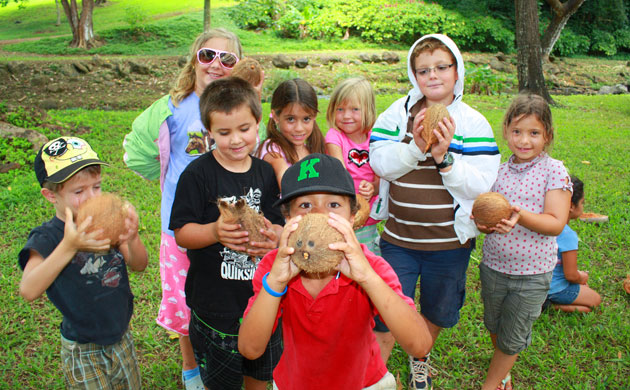

Traveller's palm
About traveller's palm.
Traveller's Tree is a palm-like tree native to Madagascar. It can reach heights of 30'-50' feet in its native habitat. It grows in frost-free areas around the world. In areas where it may not be winter hardy, it can be grown in a greenhouse.
Ravenala madagascariensis
Strelitziaceae, zingiberales, also known as.
Ravenala and Traveller's tree

How to care for Traveller's palm
How often to water your traveller's palm.

Traveller's palm needs 0.5 cups of water every 9 when it doesn’t get direct sunlight and is potted in a 5" pot.
Use our water calculator to personalize watering recommendations to your environment or download Greg for more advanced recommendations for all of your plants.

Water 0.5 cups every 9
Does your plant get direct sunlight?
Select the pot size

Finding light for Traveller's palm in your home

Traveller's palm love being close to bright, sunny windows 😎.
Place it less than 1ft from a south-facing window to maximize the potential for growth.
Traveller's palm does not tolerate low-light 🚫.
Select your region to see how the current weather in your area affects the placement of Traveller's palm in your home 🏡.
How to fertilize Traveller's palm

Most potting soils come with ample nutrients which plants use to produce new growth.
By the time your plant has depleted the nutrients in its soil it’s likely grown enough to need a larger pot anyway.
To replenish this plant's nutrients, repot your Traveller's palm after it doubles in size or once a year —whichever comes first.
The app says to water every 10 days. Is this accurate? The guy who I bought it from told me to water it every day. What’s the water usage for these plants? It’s a 15 gallon size
Just got these seeds my friend gave me these and i’m so excited any tips or tricks to help them sprout the only thing the package says is to take sandpaper to rough up the outer part of the seed and then put in peat moss but surely there’s more 😁.
Traveller's palm is generally easy to care for , though some plant parents report facing challenges with growing it. Check out the reviews down below to read more about their experiences!
Benefits of Growing Traveller's palm →
Common Traveller's palm Problems →
Traveller's palm prefers for the soil to dry out between waterings and should be watered regularly . Use our water calculator to personalize watering recommendations to your environment or download Greg for more advanced recommendations for all of your plants.
Traveller's palm Water Frequency →
- Traveller's palm Root Rot →
Traveller's palm requires abundant, bright and direct light. Place it less than one foot from a window to ensure it receives enough light to survive 💪. Select your region to see how the current weather in your area affects the placement in your home 🏡.
Traveller's palm Light Requirements →
Traveller's palm Direct Sunlight Needs & Tolerance →
Greg does not have confirmed data on this plant’s toxicity. If you, a family member, or a pet consumes plant material of unknown toxicity, it’s always best to consult a medical professional.
If you or someone else ingested this plant, call Poison Control at US (800) 222-1222 . If a pet consumed this plant, contact your veterinarian or the ASPCA at US (888) 426-4435 .
Traveller's palm does best in well-draining soil . A good soil will contain lots of organic matter such as coco coir as well as perlite or vermiculite to help with drainage. Adding a handful of perlite to regular store-bought potting soil should do the trick!
Best Soil Mix for Traveller's palm →
When and How to Successfully Repot Traveller's palm →
Traveller's palm will branch off as it grows. To encourage branching, pinch off the newest growth at the tip and the stem will branch off into two.
How and When to Prune Traveller's palm →
USDA Hardiness Zone Traveller's palm can be grown outdoors in USDA Hardiness Zones 10a-11b . Find your local hardiness zone here .
Traveller's palm Temperature Tolerance →
Traveller's palm can be propagated by division into new individual plants.
- Check to see if there is more than one plant. In some cases they may still be beneath the soil surface. If you feel confident, you may remove the soil to check for baby plantlets below!
- If there are multiple plants growing, unpot the plant and gently tug the plants apart, being careful not to disturb too many of the roots. They may be connected by large root segments which you may need to break to free the plantlet.
- Pot up the new plant in well-draining soil
- Repot the parent plant back into its original pot
When troubleshooting a sad-looking houseplant, start by checking for signs of distress in its leaves, such as yellowing, browning, or drooping, which can indicate overwatering or nutrient deficiencies.
Inspect the soil moisture; too dry or too wet soil can cause problems.
Finally, consider environmental factors like temperature and humidity, and adjust care routines accordingly to revive your plant.
- Common Bugs Affecting Traveller's palm →
- Drooping Traveller's palm Leaves →
- Traveller's palm Dropping Leaves →
- Traveller's palm Mushy Leaves →
- Black Spots on Traveller's palm →
- Brown Spots on Traveller's palm →
- Traveller's palm Leaves Falling Over →
- Traveller's palm Leaves Curling →
- Traveller's palm Yellow Leaves →
Care Summary for Traveller's palm

0.5 cups every 9 days

< 1ft from a window

Repot after 2x growth
Based on the 4” pot your plant is in, and that it doesn’t get direct sunlight .
Trending in your area

Arrowhead Plant

Philodendron Brasil

Dwarf Umbrella Tree

Split Leaf Philodendr…

Neon Pothos

Tradescantia Nanouk

Cornstalk Dracaena

White Bird of Paradise

Golden Pothos

Marble Queen Pothos

Polka Dot Begonia

String of Hearts

Fiddle Leaf Fig

African Violet

Cathedral Windows

Rex Begonia

False Christmas Cactus

Similar to Traveller's palm

Bird of Paradise

Narrow-Leaved Bird of…

variegated birds of p…

실새풀, 실새풀(새풀)
✨ discover rare plants.

Black Monkey Thorn Tr…

Tuber Fleeceflower

Ceropegia simoneae

Phalaenopsis schiller…

Begonia hydrocotylifo…

Scotch Moss

Aglaonema Spitfire

Astroloba congesta

Skeleton Key Pothos

Treasure Flower

Linnaei Kunth

Anthurium 'Fantasy Lo…

Cigar Plant

White Apple Moth Orch…

Sedum 'White Diamond'

Anastasia Weeping Fig

Bonsai Crassula

Traveler’s Palm: Identification, Uses, Growing guide

One of the most fascinating features of the Traveler’s Palm is the way its leaves are oriented. They tend to grow in an east-west direction, which gives travelers the impression that the plant serves as a natural compass, aligning with the east-west axis.
The Traveler’s Palms are sometimes considered similar to the Banana Plant and the Bird of Paradise, but they belong to different botanical families and have distinct characteristics.
Where Are Traveler’s Palms found?
Traveler’s Trees are native to the island of Madagascar, which is located off the southeastern coast of Africa. These tropical plants are primarily found in the wild in the tropical and subtropical regions of Madagascar.
What Are You Foraging For Right Now?
We're thrilled to hear your ideas. what would you like to submit today feel free to share your thoughts and experiences with us..
Traveler’s Palms can be found in U.S. states that have a warm climate and meet the growing requirements of these plants (USDA 9-11), including in Southern Florida, Southern California and Hawaii.
In their native habitat, Traveler’s Palms can be seen growing in various landscapes, including rainforests, humid forests, and along watercourses. They thrive in areas with warm temperatures, high humidity, and consistent rainfall.
Why is it Called Traveler’s palm?
The name “Traveler’s Palm” is derived from the unique arrangement of the leaves , which can resemble a fan or an open hand . These leaves are oriented in an east-west direction, allowing them to catch and collect rainwater at their bases, forming natural reservoirs. This feature gave rise to the plant’s common name and the associated myth that travelers could find drinkable water in the leaf bases to quench their thirst.
The ‘Water Source for Travelers’ Myth
Despite the misconception that these rainwater-filled leaf bases could serve as a convenient water source for travelers, it’s important to note that the water collected in the leaves is often not suitable for drinking due to the risk of contamination and limited quantity.

How Do You Identify the Traveler’s Palm?
Leaf arrangement and orientation.
The most distinctive feature of the Traveler’s Palm is the arrangement of its leaves. The leaves are large, paddle-like, and fan-shaped. They grow in a single plane, creating a symmetrical and striking appearance.
The leaves are arranged in a predominantly east-west direction . This orientation gives the appearance of an open fan or hand, with the tips of the leaves pointing in the direction of the sun’s movement.
Each leaf is composed of a long petiole (leaf stem) and a wide, flat blade. The leaf color is primarily vibrant and rich green.
The Traveler’s Palm produces large, white, bird-of-paradise-like flowers that emerge from the leaf axils. The flowers have a unique structure and coloration that makes them visually distinct.
Seed Capsules
After flowering, the plant produces seed capsules that contain numerous flat, winged light blue seeds .
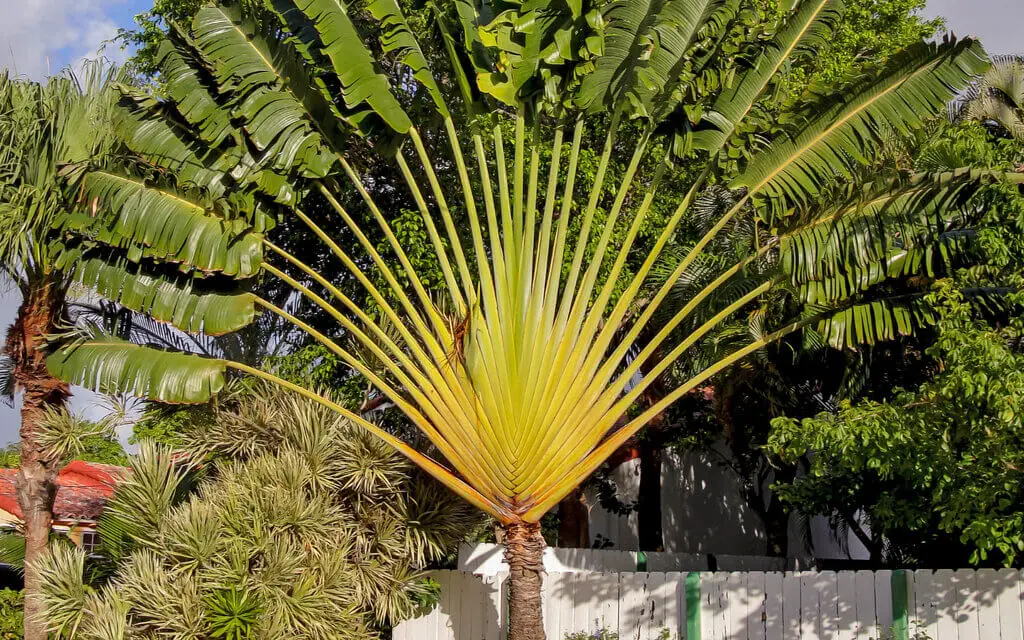
How tall do traveler’s palms grow?
On average, a mature Traveler’s Palm can reach heights of around 30 to 40 feet (9 to 12 meters).
However, some well-cared-for specimens have been known to grow even taller, occasionally reaching heights of up to 50 feet (15 meters) or more.
Traveler’s Palm vs. Bird of Paradise vs. Banana Tree
While the Traveler’s Palm, Bird of Paradise (Strelitzia reginae) and the Banana tree (Musa spp. ) are visually stunning and evoke tropical landscapes, they have different leaf arrangements, flowers, sizes, and growth requirements.
The Traveler’s Palm is known for its fan-shaped leaves and the myth of providing water for travelers, while the Bird of Paradise is recognized for its distinctive orange and blue flowers that resemble a bird in flight.
The Banana Tree is recognized for its pseudostem, edible fruits, and its widespread cultivation as a food crop and ornamental plant.
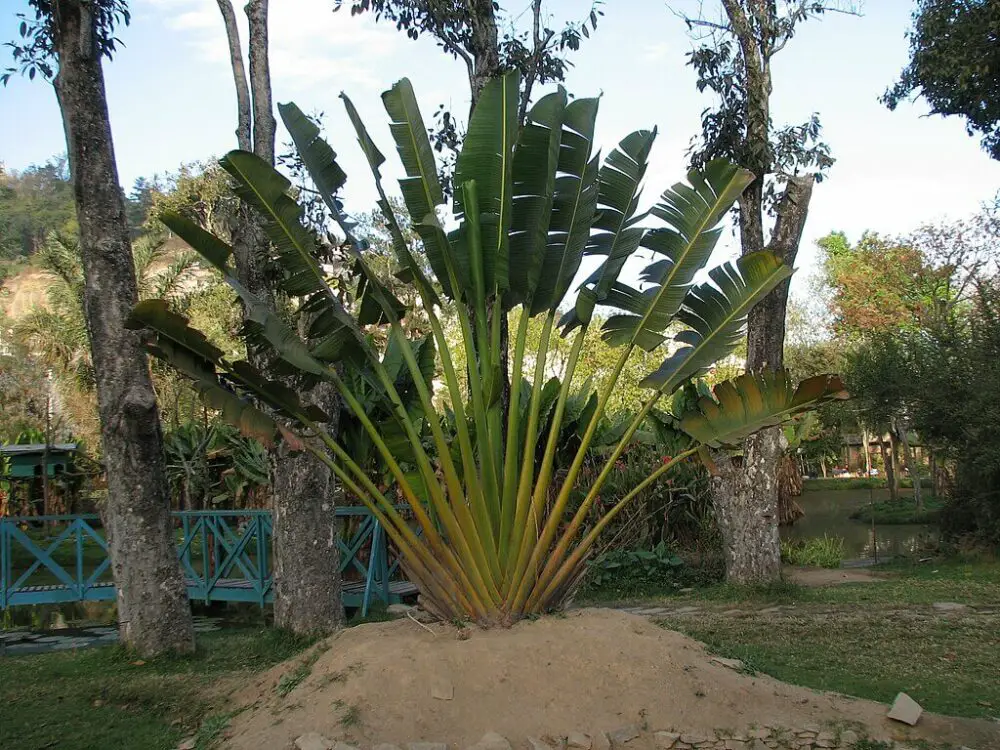
What is a common use for traveler’s palms?
Traveler’s Palms are often used in landscaping to add a touch of the tropics to outdoor spaces.
Are any Parts Edible?
The Traveler’s Palm is primarily known for its ornamental value and landscaping uses. There is limited reliable information regarding its credibility.
Its young leaves and starchy young fruit are used as food in certain regions. so are the oily blue seeds and the sap extracted from the leaves, which is sometimes used to make syrup.
If you’re interested in foraging plants that are great for making jellies and syrups, check out these:
- Chokecherries
- Honeysuckle
- Nannyberries
- Blue violets
Growing and Caring for a Traveler’s Palm Tree
You’ll need patience with the Traveler’s Palm, as it’s slow to develop and won’t flower until it’s about ten years of age.
But there are a few tips that can help your Ravenala madagascariensis thrive.
- Once flowering begins, you can expect it to bloom mainly in summer . However, it may produce flowers all year.
- Although it doesn’t need full sun until it’s larger, the traveler’s plant needs a sunny spot.
- Using fertilizer is a great idea, as it responds well, especially when the growing season finds it high in nitrogen. Using a feed will allow the Traveler’s Palm to grow better, demonstrating better foliage.
- Although you want to avoid any climates out of the USDA 10 and 11 zones, this Ravenala species only requires minimal water under the right conditions.
What to read next: Spider Flower: identification, Recipes And Cultivation
How useful was this post?
Click on a star to rate it!
We are sorry that this post was not useful for you!
Let us improve this post!
Tell us how we can improve this post?
Getting into the great, wet outdoors in search of edible plants, herbs, fruits and fungi is one of Sarah’s favorite outdoor pursuits. She thinks there’s nothing better than combining her passion for hiking with the start of the foraging season. Sarah’s definitely not afraid of a little rain and dirt, it’s all part of the fun.
Leave a Comment Cancel reply
Remember Me!
Connect with the Foraging Community
Whether you have a question about identifying a new plant or mushroom you found, or want to share photos from your latest foraging adventure, our site is the place to reach other foraging enthusiasts.
Digital Authority Group
N28W23000 Roundy Dr. Pewaukee, WI 53072
Traveller’s Palm Indoors (Ravenala madagascariensis)

Please login to bookmark
Only fill in if you are not human
No account yet? Register
Plant Details
Keep soil evenly moist and fertilize regularly.

Water once a week.

Organic-rich, well-drained soil.

Apply mild liquid fertilizer monthly.

Traveller’s Palm is not a true palm, in fact it’s fanned branching structure and foliage are distinctively different from the typical palm. The common name comes from the plant’s unique, somewhat two-dimensional fan of foliage that tends to align in an east-west direction when growing in its natural habitat. As a result of this interesting growth habit a wandering traveler could use this tree to gain a sense of direction, just like a compass. This “flat” fan of foliage enables it to be used in places where height is desired without taking up a wide range of space.
A spectacular potted plant for large indoor spaces with bright windows. Can also be grown outdoors in a patio planter during the summer and brought indoors for the winter.
Traveller’s Palm Indoors (Ravenala madagascariensis) Care Guide
- Planting Guide
- Watering Guide
- Pruning Guide
- Fertilizing Guide
Start with a good quality, commercial potting soil. These are usually lighter in weight than topsoil, sterile and pest-free. Many are available with a mild starter fertilizer in the mix.
Select a container with a drainage hole or be prepared to drill holes for drainage if there are none.
Prepare the container by filling with potting soil up to 2” (5cm) from the rim of the planter. Remove the plant from its pot.
Make a small hole in the soil slightly larger than the root ball either by hand or using a trowel. Insert the plant into the hole and press soil firmly around the roots and just covering the root ball. When all the plants are potted, water thoroughly to settle the soil and give plants a good start. Place plant in a reliably sunny location.
Repot every 2 years in the same container or in a container slightly larger than the diameter of the roots.
Prefers moist but well-drained soil. Check the soil moisture with your finger. If the top 2-4” (5-10cm) of soil is dry, or plants are wilted, it is time to water.
Apply water at the soil level if possible to avoid wetting the foliage. Water the entire soil area until water runs out the base of the pot. This indicates that the soil is thoroughly wet.
Most container plants can be pruned freely to maintain the desired size and shape. Keeping the foliage trimmed also keeps the plants looking neat and tidy, encourages the plant to develop more side-shoots and flowers, and reduces the demand for the plant to develop a larger root system. This is important since the roots are in a confined space.
Fertilizers are available in many forms: granulated, slow-release, liquid feeds, organic or synthetic. Determine which application method is best for the situation and select a product with a nutritional balance designed for foliage plants.
Too much fertilizer can damage plants so it’s important to follow the package directions to determine how much, and how often, to feed plants.
Slow-release fertilizers are an especially good, care-free choice for container plants. A single application can often provide plants with the proper level of nutrition all season long.
Companion/Combination Plants

Peace Lily (Spathiphyllum hybrid)

Dumb Cane (Dieffenbachia species)
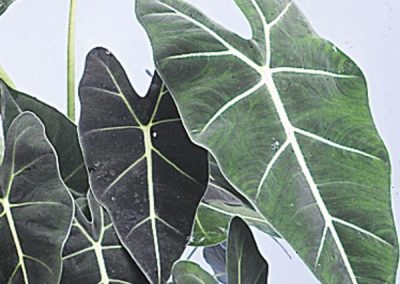
Alocasia, Elephant’s Ear (Alocasia species)

Last re-potted at least 2 years ago it is leaning heavily to one side. Guess I have to take the repot every 2 years rule seriously.

Hi Margaret, It definitely sounds like it’s time to repot your traveler’s palm and realign your plant so that it’s upright again. Transplanting every two years is an opportunity to judge whether your plant needs a larger pot, as well as refresh the soil that has become compacted and depleted of nutrients over time.
Submit a Comment Cancel reply
Your email address will not be published. Required fields are marked *
Save my name, email, and website in this browser for the next time I comment.
Submit Comment
Find more plants for your garden or home!
Pin it on pinterest.
Share this post with your friends!

How to Grow the Travelers Palm Tree (Ravenala madagascariensis)
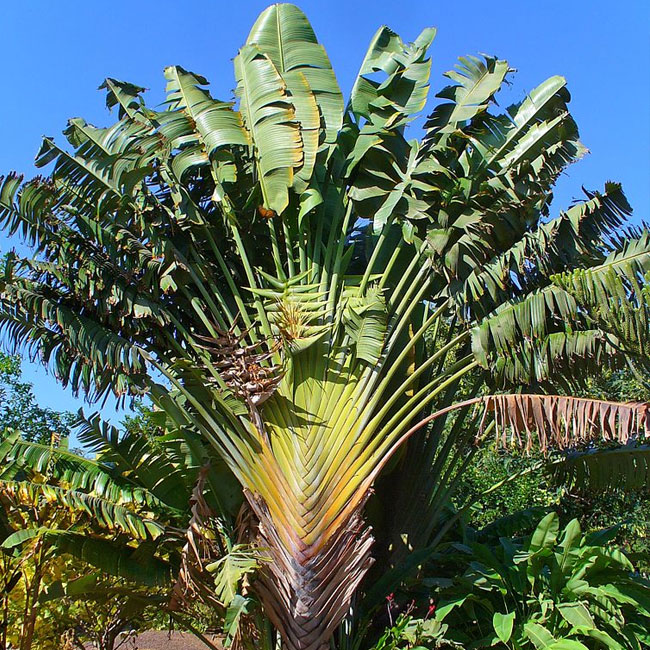
The Travelers Palm Tree, scientifically known as Ravenala madagascariensis , stands out as one of the world’s most recognizable palm trees, thanks to its stunning fronds that transition in color from orange to yellow to green.
It is native to the island of Madagascar, which is located in the Indian Ocean off the southeastern coast of Africa. It is not naturally found anywhere else in the world and is endemic to Madagascar.
This adaptable palm thrives in a wide range of soil types, making it a perfect choice for creating a delightful shaded area in your yard or by the pool.
Quick Facts:
Identifying characteristics of the travelers palm.
In its early stages, the Travelers Palm boasts a subterranean trunk that grows beneath the surface. As it matures, it develops a distinctive short green trunk, approximately 1 foot in diameter, adorned with unique leaf scar rings.
With approximately 30-35 large, fan-shaped leaves that reach lengths of up to 10 feet, this palm’s foliage bears a striking resemblance to banana leaves. These leaves are symmetrically grouped, lending the tree the appearance of a hand fan.
During high winds, the leaves can take on a feather-like appearance due to their shredding. The leaf stems exhibit a captivating gradient of color, ranging from orange at the base, transitioning to yellow in the middle, and culminating in a vibrant green nearer the tip.
An interesting feature of the Travelers Palm is its leaf stems’ ability to store a significant amount of rainwater, which can serve as an emergency drinking supply during droughts. The palm derives its name from numerous accounts of travelers seeking this tree as a source of water.
Flowers and Fruits of the Travelers
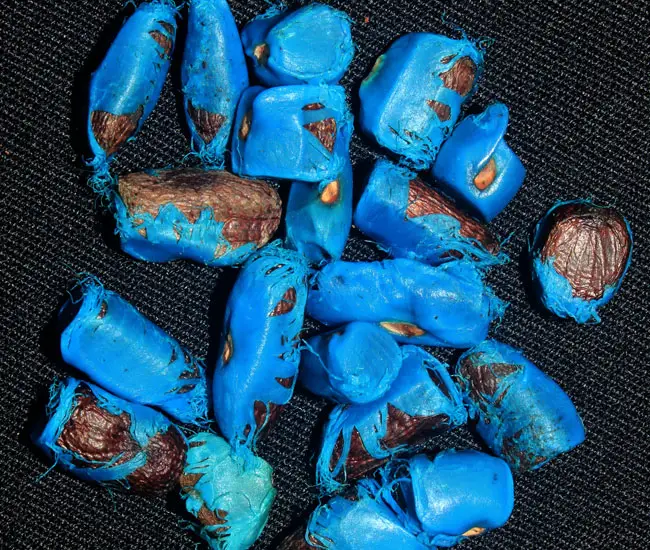
The Travelers Palm produces white flowers, supported by large green flower stalks, with some blossoms reaching sizes as large as 2 feet in diameter. The leaf stalks resemble narrow bowls, efficiently collecting rainwater and becoming quite heavy.
Following the blooming phase, brown fruits appear, opening to reveal stunningly bright blue seeds inside.
Caring for the Travelers Palm
Ravenala madagascariensis exhibits a medium growth rate, reaching heights of 40-60 feet and boasting a spread of 10-15 feet.
Remarkably, the Travelers Palm Tree can withstand cold temperatures down to 30°F, making it suitable for cultivation in USDA Zones 10a (30 – 35°F) to 11 (above 40°F). While it thrives in full sun, it can also adapt to light shade.
This palm thrives in moist, well-drained soil, and its adaptability extends to both sandy and clayey soils. Native to Madagascar, the Travelers Palm Tree effortlessly fits into various soil types and serves as an impressive centerpiece in any landscape.
To prevent nutritional deficiencies, it’s recommended to apply a high-quality palm fertilizer with a continuous-release formula twice a year during the growing season.
Propagation can be achieved through seeds or division of clumps, providing options for cultivating this captivating palm.
Travelers Palm Tree Pictures
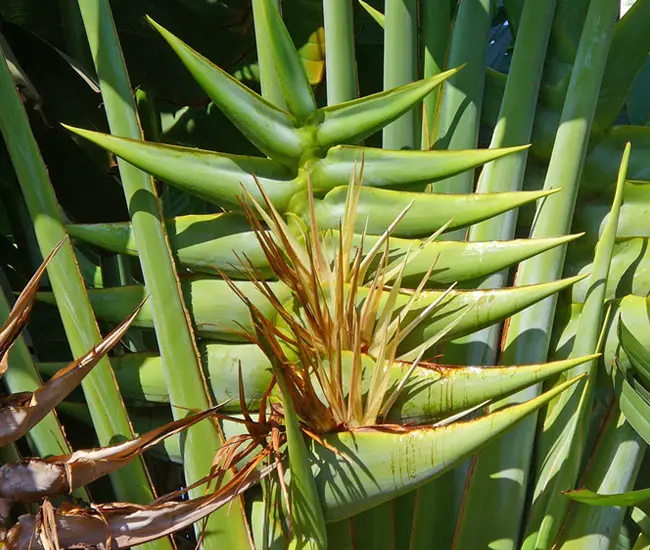
More information can be found on Floridata site.
Latest posts:
3 thoughts on “how to grow the travelers palm tree (ravenala madagascariensis)”.
I need three 8′ travelers palms for the interior.
Looking for a couple of palm trees to be used outside a pool cage. Must be 4 to 5 feet high and thick at the bottom for real privacy. Thanks.
I’m trying to figure out how long it takes until the trunk becomes visible? We like the way it looks, but typically before it gets the trunk.
Comments are closed.
- Search for:
- House Plants
- Cacti & Succulents
- Diseases and Pests
As an Amazon Associate we earn from qualifying purchases at no added cost to you. Learn more .
Travelers Palm Care (Ravenala Madagascariensis) Tips For Growth

Table of Contents
The maintenance of the unusual indoor plant Ravenala madagascariensis differs slightly from that of conventional palms. The Travelers palm resembles a banana tree or bird of paradise a little more.
However, it gets its name from the distinctive fan-shaped leaf that grows naturally in an east-west orientation, making it useful for travelers to recognize which way they are moving. This palm was taken from its natural habitat, like many other houseplants, and has been thriving in a lot of homes as a tropical accent to their décor.
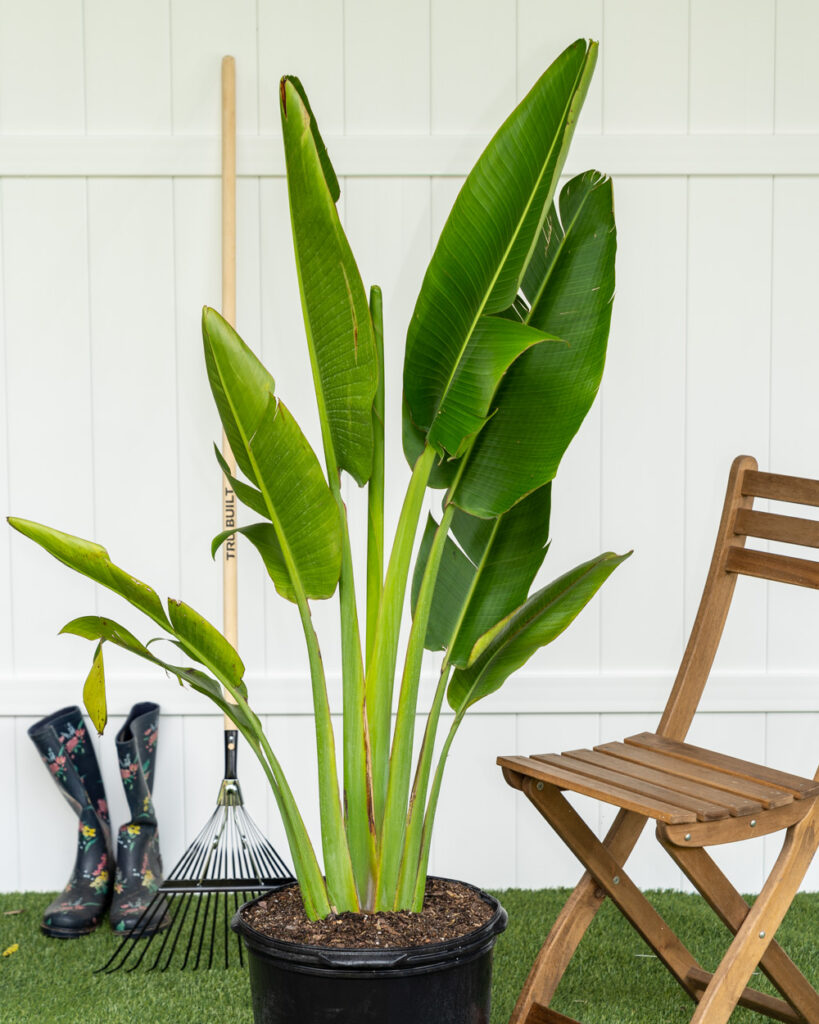
Overview About The Travelers Palm (Ravenala Madagascariensis)
Anecdotally known as the east-west palm or the traveler’s palm, Ravenala madagascariensis. Its distinctive fan-shaped leaves, which grow in an east-west orientation by nature, give rise to its name. This tree, which is native to Madagascar, was once used to determine direction, much like a compass.
The leaf bases and bracts of this plant also catch and store rainfall, making it a beautiful find for thirsty visitors who may subsequently find up to a half-gallon of fresh water contained within it.
There is even folklore that says you may make a wish, and it will come true if you stand in front of a traveler’s palm, making it a very lucky discovery. Since then, it has grown to be one of the most popular indoor tropical plants for workplaces and homes.
Travelers Palm Caring Tips
Watering travelers palm.
The traveler’s palm is a rainforest native that likes to be always damp. Despite the fact that this plant needs frequent watering, you should be careful not to overwater and wait until the top one to two inches of soil have dried up before rewatering. The plant should never be immersed in standing water in the plant’s tray, and your container should have good drainage.
The ideal soil for a Travelers palm
The Travelers palm will tolerate some sand but prefers slightly acidic loamy soil. A regular potting mix with additions of organic matter, such as compost, and additives to promote drainage, such as vermiculite or perlite, is an ideal growth medium for ravenala madagascariensis.
Fertilizer for Traveling palms
During the spring, summer, and fall, Ravenala madagascariensis will benefit from a single application of nitrogen-rich fertilizer for tropical plants and palms. Follow all label directions. Fertilize not throughout the winter.
Light Requirements for Travelers Palm
This big tree should get enough sunlight because it loves the sun. This plant thrives in a sunroom, greenhouse, or a large window with southern exposure. Low light is not tolerated well by Traveler’s palm.
Temperature & Humidity for Travelers Palm
Because Ravenala madagascariensis prefers warm temperatures, temperatures below 60 degrees Fahrenheit should never be allowed because they will cause the plant substantial stress. Temperatures between 65 and 85 F are ideal for growth. Being tropical plants, they prefer greater levels of humidity when cultivated indoors, such as those provided by a humidifier.

- HOME DECOR ACCENT: A beautiful lifelike plant that is the perfect accent for any room or space, allowing for year-round greenery. This 7-foot artificial traveler’s palm tree has large, upright facing leaves that grow out of multiple stems. With its height and unique looking leaves, it would be a great ornamental piece for your indoor porch.
- CRAFTED OF QUALITY MATERIALS: Our designers have years of experience in the live plant industry; Nearly Natural fake plants, trees, and other artificial greenery are inspired by nature and crafted from premium materials to mimic the outdoors
- DIMENSIONS & SIZE: Product Dimensions: 14 In. W x 14 In. D x 84 In. H ; Nursery Pot Dimensions: H: 6.5 In. W: 7.5 In. D: 7.5 In. ; Measurements are calculated from each furthest outstretched dimension
- EASY TO MAINTAIN: Bendable branches and stems allow for easy reshaping to reach the desired fullness and shape. To ensure your artificial trees and faux plants always look fresh, dust once a month with a feather duster
Last update on 2024-04-06 / Affiliate links / Images from Amazon Product Advertising API
Pruning and Maintaining Travelers Palm
The traveler’s tree doesn’t need a lot of trimming. To avoid an untidy look and the production of leaves, root suckers may be removed from the base of the trunk. Branches will form when you pinch off new growth at the tip to encourage branching.
Every one to two years or when roots are visible peeking through the drainage holes, this plant has to be potted again. Always pot your plants in the spring. Choose a container with drainage holes that is one to two inches bigger than the original container.
To repot, fill the new container with fresh potting soil, gently remove the Travelers palm from the planter it is now in, insert the root ball in the planter, push down any loose soil, add more potting soil as necessary, and water well.
To prevent it from becoming top-heavy and toppling over, this tree should be kept in a fairly large container. When a plant reaches a size that makes it unsuitable for the inside, many people instead decide to move it outside if the climate permits.
How To Propagate Travelers Palm
The palm tree of the traveler may be simply multiplied via division. Simply pull the rooted suckers growing close to the trunk’s base apart and transplant them. You may need to gently untangle any roots that are tangled up with the mother plant. Make sure the mother plant is completely covered in dirt before planting the baby plant in a pot filled with wet, well-aerated soil.

Toxicity in Travelers Palm
Humans, cats, and dogs are all said to be harmful to the traveler’s palm tree. Keep this plant out of the reach of youngsters and domestic pets, and avoid consuming it. The young leaves, seed oil, and fruits of Ravenala madagascariensis have all been used medicinally throughout history despite being bitter.
Traveler’s palm, on the other hand, is thought to be only minimally harmful to humans and should never be taken in any form since it might have negative side effects, including upset stomach.
Toxicity to Dogs and Cats
Pets should never consume Traveler’s palm because it is thought to be only minimally poisonous to them. You should call your veterinarian if you think your pet may have eaten any of this plant.
Issues you may have with Travelers Palm Palm
Leaves turning yellow on travelers palm.
The traveler’s palm’s leaves may frequently turn yellow from nutritional deficiency or overwatering. Before watering, make sure the top one to two inches of soil have dried off. To make sure the palm tree gets the nutrients it needs, fertilizes it once in the spring, summer, and fall.
Leaves Turning Brown on Travelers Palm
The Travelers palm may develop brown leaves as a result of excessive fertilizing, watering, and poor drainage. Make sure it doesn’t get too much fertilizer or water. If you are doing this correctly, check your plant’s drainage tray to make sure there isn’t any standing water since this might be the cause of the browning of the leaves.
Diseases of the Traveling Palm
The indoor plant Ravenala madagascariensis is regarded as disease-resistant. However, excessive irrigation could cause problems.
Pests in Travelers Palms
There are no documented pest difficulties with Ravenala Madagascariensis, which is pest-resistant. However, it might get an infestation, much like many indoor plants. When an infestation is discovered, separate the area and treat it with a pesticide according to all label directions.
Frequently Asked Questions About Travelers Palm
What is the growth rate of travelers palms.
A traveler’s palm takes 10 years to blossom due to its sluggish growth. Once flowering starts, it will bloom primarily in the summer but may also produce blooms all year long. The resultant edible seeds give this plant a wide range of useful applications.
Why do they go by the name Traveler Palms?
The Traveler’s tree, also known as the Traveler’s palm, is a member of the Strelitziaceae family of plants. It gets its common name from the fact that people have historically drank from the water that collects at the bases of its leaves during times of need.
Do Travelers palms spread?
Anywhere you plant, remember which way the foliage’s crown will grow. Place this plant no closer than 8 to 10 feet from the home since it grows to be a very huge and wide-spreading plant.
Leave a Reply Cancel reply
Your email address will not be published. Required fields are marked *
Save my name, email, and website in this browser for the next time I comment.
Username or email address *
Password *
Remember me Log in
Lost your password?
- Become a member
- Find a plant
- Plants for places
- Trials & awards
- Plantsmanship
Ravenala madagascariensis
traveller's palm
A palm-like, evergreen tree eventually reaching up to 10m tall with an unbranched trunk topped with a fan-shaped crown of dark green leaves arranged in a single plane. The leaves are long-stalked, 3-6m long and have expaned, cup-shaped leaf bases. White-petaled flowers appear in summer from groups of boat-shaped spathes that emerge at the leaf axils
Other common names
Join the RHS today and save 25%
Buy this plant
- Plant nurseries 3 suppliers
Ultimate height
Time to ultimate height, ultimate spread, growing conditions, colour & scent.
Southâfacing or Westâfacing
Hardiness Hardiness ratings
All ratings refer to the UK growing conditions unless otherwise stated. Minimum temperature ranges (in degrees C) are shown in brackets
- H1a : under glass all year (>15C)
- H1b : can be grown outside in the summer (10 - 15)
- H1c : can be grown outside in the summer (5 - 10)
- H2 : tolerant of low temperatures, but not surviving being frozen (1 to 5)
- H3 : hardy in coastal and relatively mild parts of the UK (-5 to 1)
- H4 : hardy through most of the UK (-10 to -5)
- H5 : hardy in most places throughout the UK even in severe winters (-15 to -10)
- H6 : hardy in all of UK and northern Europe (-20 to -15)
- H7 : hardy in the severest European continental climates (< -20)
Botanical details
Advertise here
How to grow
Cultivation.
Under glass grow in loam-based compost, in a large container or greenhouse bed, in full light with shade from hot sun. During growth, water freely and apply a balanced liquid fertiliser monthly. Water sparingly in winter
Propagation
Propagate by seed sown at 18-21°C in spring or division of rooted suckers in spring
Suggested planting locations and garden types
- Architectural
- Patio and container plants
- Sub-tropical
- Conservatory and greenhouse
No pruning required
May be susceptible to glasshouse red spider mite
Generally disease-free
Get involved
The Royal Horticultural Society is the UKâs leading gardening charity. We aim to enrich everyoneâs life through plants, and make the UK a greener and more beautiful place.
Solotravellertip
Travelers Palm: A Comprehensive Guide to Care and Maintenance

Table of Contents
Introduction:
Travelers Palm (Ravenala Madagascans) is a fascinating and exotic plant known for its unique appearance and tropical allure. Native to Madagascar, this stunning plant has captured the hearts of many plant enthusiasts around the world. so now, we will explore various aspects of Travelers Palm care, from temperature tolerance to landscaping around these majestic trees.

Understanding Travelers Palm:
The Travelers Palm, despite its name, is not a true palm. It belongs to the Strelitziaceae family and is botanically related to the banana plant. Its distinctive features include large, fan-shaped leaves that give the illusion of a traveler’s fan, thus earning its common name.
Temperature Tolerance:
Travelers Palms thrive in warm, tropical climates and are known for their excellent temperature tolerance. They can withstand a range of temperatures, but they prefer consistently warm conditions. In colder climates, it’s essential to protect the plant from frost, as prolonged exposure can damage the leaves.
Palm Tree Height and Characteristics:
Travelers Palms are renowned for their impressive height, reaching up to 30 feet in their natural habitat. When cultivated as a landscape plant, they can still grow to a considerable height. Their tall, slender trunks and large leaves make them a striking addition to gardens and tropical landscapes.

Palm Cutting and Propagation:
Propagating Travelers Palms is possible through seed germination or by using offshoots, also known as suckers. When taking palm cuttings, ensure they have roots attached and plant them in a well-draining soil mix. Regular watering and protection from harsh conditions will aid in successful establishment.
Dead Palm Tree: Signs and Solutions:
Like any plant, Travelers Palms can face issues, including the possibility of a dead palm tree. Recognizing signs such as yellowing leaves, decay, or stunted growth is crucial. If your palm shows signs of distress, prompt action such as pruning dead fronds and addressing root issues can help revive it.
Madagascar Palm Care:
Proper care for Travelers Palms involves providing well-draining soil, adequate sunlight, and regular watering. These plants also benefit from occasional fertilization, promoting healthy growth and vibrant foliage. Maintaining optimal humidity levels will mimic their native environment, ensuring their well-being.
Palm Tree Trimming Before and After:
Trimming Travelers Palms is essential for maintaining their aesthetic appeal and overall health. Pruning dead or damaged fronds should be done with care to prevent stress on the plant. Before and after palm tree trimming, it’s crucial to observe proper techniques to encourage healthy regrowth.
Landscaping Around Palm Trees:
Travelers Palms serve as captivating focal points in landscaping. Designing around these trees involves selecting companion plants that thrive in tropical conditions. Ground covers, colorful flowers, and other palm varieties can complement the unique beauty of Travelers Palms.
Palm Plant Turning Yellow: Causes and Solutions:
Yellowing of palm leaves can be indicative of various issues, including nutrient deficiencies or waterlogged soil. Understanding the causes and implementing corrective measures, such as adjusting watering routines or applying appropriate fertilizers, is vital to restoring the plant’s vibrancy.
Palm City Nursery and Plant Diversity:
Palm City Nurseries play a crucial role in providing enthusiasts with a diverse range of palms, including Travelers Palms. Exploring such nurseries allows for access to expert advice and high-quality specimens, ensuring a successful gardening experience.

Palm Tree Leaves Turning Brown: Addressing Common Concerns:
Brown leaves on Travelers Palms may signify problems like nutrient deficiencies, overwatering, or pests. Identifying the root cause and addressing it promptly through proper fertilization, adjusting irrigation, or applying appropriate treatments can restore the plant’s health.
The Palm Tree: Symbolism and Cultural Significance:
Beyond their horticultural value, palm trees hold cultural significance worldwide. They are often associated with tropical paradises and symbolize resilience, victory, and peace in various cultures.
Tree Types in Florida and Florida Tree Species:
Travelers Palms find a natural home in Florida, where various palm species thrive. Exploring the diverse tree types in Florida, including native and non-native species, enhances one’s appreciation for the state’s rich botanical tapestry.
Pygmy Palms Care: Miniature Marvels:
Pygmy palms, like the popular Roebelenii Palm, add a touch of elegance to landscapes. Understanding their care requirements, including proper watering and sunlight exposure, ensures these miniature marvels flourish in gardens and indoor spaces.
Plant Instructions and Palm Pros:
Following plant instructions and seeking advice from palm pros contribute to successful Travelers Palm cultivation. Professionals in the field can offer tailored guidance on specific care needs, pest management, and landscape design, ensuring a thriving and visually appealing garden.
Palm Plant Pests and Diseases:
Vigilance is crucial in protecting Travelers Palms from pests and diseases. Common issues include spider mites, scale insects, and fungal infections. Regular inspection and prompt treatment with organic or chemical remedies can prevent widespread infestations and keep the plant healthy.
Practical Palm Care Tips:
Enhance your palm care routine by providing proper support for the trunk in windy conditions. Mulching around the base helps retain moisture and regulate soil temperature. Additionally, periodic soil testing can guide fertilizer applications, ensuring the plant receives essential nutrients.
Travelers Palm in Indoor Spaces:
While typically an outdoor plant, Travelers Palms can be cultivated indoors if provided with adequate light. Ensure they receive bright, indirect sunlight and maintain a humid environment. Container gardening allows for flexibility in moving the plant based on seasonal changes.

Propagating Travelers Palms from Seeds:
Growing Travelers Palms from seeds offers a rewarding experience. Extract seeds from mature fruits, clean them thoroughly, and sow them in a well-draining mix. Patience is key, as germination may take several weeks. Provide consistent warmth and moisture for successful seedling development.
Fertilization Schedule:
Developing a regular fertilization schedule is essential for Travelers Palms. Use a balanced, slow-release fertilizer during the growing season to promote healthy foliage and robust growth. Adjust the application rate based on the plant’s size and specific nutrient requirements.

Watering Techniques:
Proper watering is critical for Travelers Palms. They prefer consistently moist but well-draining soil. Water deeply and allow the topsoil to dry slightly between waterings. Avoid waterlogged conditions, as this can lead to root rot. Adjust the frequency based on environmental factors such as temperature and humidity.
Palm Tree Identification:
Familiarize yourself with various palm tree species, including their distinct characteristics. This knowledge not only enhances your appreciation for the diversity within the palm family but also aids in proper care and maintenance, as different species may have unique requirements.
Caring for Newly Planted Palms:
Newly planted Travelers Palms require extra care to establish themselves. Provide a stable support structure, protect against harsh weather conditions, and water consistently to aid root development. Applying a layer of organic mulch helps retain moisture and provides insulation.

Landscaping Aesthetics:
Integrate Travelers Palms into your landscaping design for maximum visual impact. Consider factors such as height, spacing, and color contrasts with surrounding plants. Creating focal points and using palms as background elements can enhance the overall aesthetics of your garden or outdoor space.
The Art of Palm Tree Photography:
Capture the beauty of your Travelers Palms through photography. Experiment with different angles, lighting conditions, and focal lengths to showcase the unique features of the plant. Share your palm tree photography on social media to inspire and connect with fellow plant enthusiasts.
Palm Tree Conservation:
Acknowledge the importance of palm tree conservation. Many palm species, including the Travelers Palm, face threats in their natural habitats. Supporting conservation efforts, choosing sustainably sourced palms, and practicing responsible gardening contribute to the preservation of these iconic plants.

Educational Resources and Forums:
Stay informed and engaged with the plant community by exploring educational resources and participating in online forums. Platforms dedicated to palm enthusiasts offer valuable insights, troubleshooting tips, and an opportunity to connect with like-minded individuals sharing a passion for Travelers Palms.
Palm Tree Symbolism Around the World:
Delve into the cultural significance of palm trees worldwide. From religious symbolism to representations of victory and triumph, palm trees hold diverse meanings in different cultures. Understanding this symbolism adds depth to your appreciation for the Travelers Palm and its global significance.
Creative Uses of Palm Fronds:
Embrace the versatility of palm fronds in creative projects. Use dried fronds for crafting, creating natural decor, or even constructing small structures. Exploring artistic expressions with palm fronds adds a unique dimension to your gardening experience.
Interactive Gardening Workshops:
Attend gardening workshops or webinars focused on palm care and landscaping. Engaging in hands-on sessions provides practical insights, allows for networking with experienced gardeners, and fosters a sense of community among individuals passionate about Travelers Palms and tropical plants.
Conclusion:
The Travelers Palm is a remarkable addition to any garden or landscape, offering a touch of the tropics with its unique features. By understanding its care requirements, addressing common concerns, and exploring the diverse world of palms, enthusiasts can cultivate and enjoy these majestic plants to their fullest potential. Whether you’re a seasoned gardener or a beginner, the journey with Travelers Palms promises a rewarding and visually stunning experience.

Read More: Dating Me is Like: Hinge-ing Into a World of Possibilities
Water deeply when the topsoil is slightly dry, usually every 7-10 days, adjusting based on environmental factors like temperature and humidity.
Brown leaves may result from over-watering, nutrient deficiencies, or pests; address the underlying issue promptly for healthier foliage.
Yes, they can thrive indoors with bright, indirect sunlight; ensure proper drainage and occasional outdoor exposure for optimal growth.
In their natural habitat, they can reach up to 30 feet; cultivated specimens may vary but still boast an impressive height in the landscape.
Use a balanced, slow-release fertilizer during the growing season, adjusting the application rate based on the plant’s size and specific nutrient requirements.
Recommended Articles
Ultimate guide for choosing excellent tour packages.

Best Places to Stay in Tuscany: Peak Italian Luxury Revealed

Things to Do in Cincinnati This Weekend: Best Activities and Attractions

Leave a Reply Cancel reply
Your email address will not be published. Required fields are marked *
Save my name, email, and website in this browser for the next time I comment.

Plant Detail Show Menu

Ravenala madagascariensis
Traveller's Tree is a palm-like tree native to Madagascar. It can reach heights of 30'-50' feet in its native habitat. It grows in frost-free areas around the world. Plant in rich, moist well-drained loam in the full sun. In areas where it may not be winter hardy, it can be grown in a greenhouse.
Propagate this pant by seed, division or it occasionally creates offsets.
Insects, Diseases, and Other Plant Problems: No serious problems. Overwatering can lead to root rot. Strong winds can shred leaves.

- Attributes: Genus: Ravenala Species: madagascariensis Family: Strelitziaceae Recommended Propagation Strategy: Division Seed Country Or Region Of Origin: Madagascar Dimensions: Height: 30 ft. 0 in. - 50 ft. 0 in. Width: 15 ft. 0 in. - 25 ft. 0 in.
- Whole Plant Traits: Plant Type: Tree Woody Plant Leaf Characteristics: Broadleaf Evergreen
- Cultural Conditions: Light: Full sun (6 or more hours of direct sunlight a day) Soil Texture: High Organic Matter Loam (Silt) Soil Drainage: Good Drainage Moist Available Space To Plant: 12-24 feet 24-60 feet USDA Plant Hardiness Zone: 10a, 10b, 11a, 11b
- Fruit: Fruit Value To Gardener: Edible Fruit Type: Capsule Fruit Length: > 3 inches Fruit Description: Woody capsules 3 1/2" long with edible blue seeds
- Flowers: Flower Color: White Flower Inflorescence: Cyme Flower Value To Gardener: Good Dried Showy Flower Petals: 2-3 rays/petals Flower Description: A seasonal bloomer 3 petaled whilte boat-shaped spathes of flowers appear in cymes
- Leaves: Woody Plant Leaf Characteristics: Broadleaf Evergreen Leaf Type: Simple Hairs Present: No Leaf Length: > 6 inches Leaf Width: > 6 inches Leaf Description: Huge eaves form a fan shape, cup-shaped petioles collect rain-water hence the common name, as it was thought travelers used this water.
- Bark: Bark Description: 12" diameter unbranched trunk with leaf scar rings.
- Stem: Stem Is Aromatic: No
- Landscape: Landscape Location: Container Landscape Theme: Winter Garden Design Feature: Specimen

How to Grow and Care for Traveller's Palm | Ravenala madagascariensis Care and Propagation Guide
Some links in this post may be affiliate links

Botanical name: Ravenala madagascariensis Family: Strelitziaceae Common names: Traveller's Palm, Traveller's Tree, East-West Palm
Description
Traveller's Palm (Ravenala madagascariensis) or Traveller's Tree is a palm-like plant which bears paddle-shaped leaves on long petioles, arranged in a fan-shape in a single plane.
The fan comprises of about 30-45 leaves. Each fan is about 10 ft long and about 2-3 ft wide. With age, it progressively loses the lower leaves and reveals a sturdy gray trunk.
The Traveller's Palm has sheaths on the stems hold rainwater which could be an emergency source of water for needy traveller's, hence, the common name, 'Traveller's Palm'.
Though called a palm, Ravenala madagascariensis, is not a true palm. It belongs to the family, Strelitziaceae.
The genus name, 'Ravenala', comes from 'ravinala' or 'ravina ala' in Malagasy which means, 'forest leaves'.
There is only one species in this genus which comes in 4 forms (subspecies); Bemavo which is the most common, Hiranirana , Malama and Hororona which is the smallest.
Traveller's Tree can grow outdoors in warm climates and is ideal for USDA Zones 10 and 10. In the cold regions, it is grown in containers which can be brought indoors during the winter season.
Traveller's Palm's inflorescence comprises of green bracts and white flower which are less attractive than those on Bird of Paradise.
The flowers appear in summer, on maturity, after about 10 years. Once pollinated, brilliant blue seeds are formed.
Outdoors, Traveller's Palm can grow to a height of 30-50ft. Indoors, it grows to aheight of 8-10 ft.
When young it grows fast and requires very fast, therefore, it requires space but as it matures is grows much slower.
Ravenala madagascariensis (Traveller's Palm) is native Madagascar where it is found growing in humid lowland forests, montane forests, grassland or rocky areas 1500 metres above sea level.
Traveller's Palm is toxic to humans and pets. If ingested, it can cause digistive upset and other side effects. Keep the plant away from children and pets.
Related Plants
Ravenala madagascariensis is related to Strelitzia reginae (Bird of Paradise Plant) and Strelitzia nicolai (White Bird of Paradise Plant).
Where to Buy
Traveller's Palm seeds are readily available online. Buy Traveller's Palms (Ravenala madagascariensis) seeds online from Etsy.

Ravenala madagascariensis Care Indoors
Traveller's Palm (Ravenala madagascariensis) prefers bright light with 6-8 hours of direct sunshine, average warmth, humid conditions and consistently moist, fertile, well-drained soil coupled with monthly feeding during the growing season.
Traveller's Tree requires repotting every 2 years when pot-bound. Pruning is needed to keep the plant neat, to discourage pest and disease infestations and improve ventilation. Keep on reading for more on these growing conditions and how to achieve them.
Light Requirements
Traveller's Palm grows best under bright light with at least 6-8 hours of direct sunshine. Rotate the pot regularly to ensure that the plant receives light on all sides for uniform growth.
If the plant does not get adequate light, it will grow slowly. Therefore, place the plant next to a very bright window or a brightly lit place. Where the natural light is not adequate, consider investing in a grow light.
Outdoors, Traveller's Tree can be grown under direct sunlight but it needs to be protected from too hot sunshine. Do not expose the plant to direct sunlight before acclimating it as it can lead to sunburn marks (brown leaf spots).
Water Requirements
Water Traveller's Palm deeply during the growing season and keep the soil moist while allowing the top 1-2 in. of soil to dry out between waterings.
Cut down watering during the cold season to maintain the soil slightly moist as growth is minimal at this time but do not allow the soil to dry out completely.
Use water that is at room temperature to water Traveller's Tree to avoid shocking this tropical plant.
Ensure that the water is chlorine-free as the plant is sensitive to chlorine and other chemicals dissolved in water and it responds with brown speckled leaf marks.
Confirm that the pot has a drainage hole to prevent the soil from getting soggy as it can lead to root-rot disease which is indicated by brown and yellow leaves.
Temperature and Humidity
Traveller's Palm prefers average warmth between 18-29 0 C with a minimum of 13 0 C. Keep it away from drafts like air vents, radiators, heaters, windy doors and windows among others.
Traveller's Palm requires humid conditions inorder to thrive. Set the pot on a wet pebble tray or use a cool mist humidifier to raise humidity as low humidity will result in brown, crispy leaf tips and edges.
Occasionally, clean the leaves by damp-wiping with a soft cloth to get rid of dust to ensure adequate surface area for light absorption and also minimize pests infestation.
Potting Soil
The best soil for Traveller's Palm should be acidic, rich in organic matter and free-draining to prevent it from getting soggy while providing the required nutrients.
Most multi-purpose potting mixes are ideal this plant. Buy quality Potting Mix online from Etsy for Traveller's Tree.
Feed Ravenala madagascariensis with a nitrogen-rich, water-soluble fertilizer monthly during the growing season to promote growth.
Do not feed Traveller's Tree during the cold season as growth is minimal at this time therefore the plant does not need it. Excess feeding can result in brown leaves.
Flush out accumulated salts (which may have arisen from the water or fertilizers) regularly from the soil by running for a few minutes a steady stream of water through the soil until it comes out through the drainage holes. Repeat the process several times.
Repot the young Traveller's Palms at the beginning of the growing season in a pot one size larger than the current one to provide adequate space for growth.
The mature Traveller's Trees require repotting every 2 years as the plant prefers to be root-bound into a pot 1-2 sizes larger than the current one. Use a heavy pot to prevent the plant from toppling over as it can become top heavy.
Make sure that the pot has a drainage hole and that the soil is free-draining soil to prevent it from getting soggy as it can lead to root-rot disease.
Traveller's Palm Outdoor Care
Traveller's Tree can be grown outdoors in the warm climates and is ideal for USDA Zones 10-11 where there is no threat of frost, though it can tolerate upto 0 0 C for a short period without much damage.
Grow Traveller's Palm in full sun to light shade. However, protect the plant from harsh hot sunshine to prevent scorching (brown leaf spots).
Where the summers are very hot, grow Traveller's Tree in a shaded spot or in containers which can be easily moved to a shaded area when the sun is too hot.
Plant the Traveller's Palm in a sheltered place away from strong winds as they cause the leaves to be torn and ragged.
Ensure that the soil is well-drained and rich in organic matter. Avoid heavy clay soils as they retain too much water which can lead to root-rot and death of the plant.
Keep the soil moist through out the growing season while allowing the top 1-2 in. of soil to dry out between waterings for optimum growth but avoid soggy soil. Cut down on watering during the cold season as growth is reduced at this time.
Fertilize Traveller's Palm with a nitrogen-rich, water-soluble fertilizer monthly during the growing season.
Withhold fertilizer during the cold season as growth is reduced at this time and excess fertilizer can lead to brown leaves.
Space Traveller's Tree 6-8 ft apart as it is a large plant. Keep it 8-10 ft away from buildings as the roots are invasive.
Pruning Traveller's Palm involves removal of dead blooms and yellow leaves to maintain the plant neat as well as discourage pest and disease infestations. Cut the dead leaves with sharp knife or a pair of scissors.
Get rid of suckers from the base of the trunk to avoid overcrowding and improve ventilation to reduce pest and disease infestations.
Always use sterilized tools to prune your plants to minimize cross-contamination. Ensure that the cutting tool is sharp enough inorder to make clean cuts to avoid unnecessary injuries which can lead to disease infestations.
Propagation
Traveller's Palm (Ravenala madagascariensis) propagation can be done at the beginning of the growing season from seeds or by plant division at repotting time.
How to propagate Traveller's Palm from seeds
Sow the Traveller's Palm seeds about 1 in. deep in moist, well-drained soil.
Cover the set up with clear polythene to a create warm and humid conditions to hasten germination and establishment of the plants.
Place the set up in a warm, well-lit place and maintain the soil moist thorough out and avoid soggy soil as it can cause rotting.
Germination should occur in about 6-8 weeks. Allow the Ravenala madagascariensis to be well established before transplanting after which you can begin routine care.
How to propagate Traveller's Palm by plant division
During repotting, divide the mother Traveller's Palm into several sections while ensuring each divison has some roots to hasten establishment.
Pot the sections in moist, free-draining soil in individual pots.
Place the set up in a well-lit place and maintain the soil moist until new growth emerges on the sections.
Ensure that the crown of the sections is above the soil level to avoid rotting.
Allow the new Ravenala madagascariensis to be well established before transplanting after which you can begin routine care.

Ravenala madagascariensis Problems
Traveller's Palm (Ravenala madagascariensis) growing problems include brown leaf tips and edges, yellow leaves, brown leaves, leaf spots and marks, pests and diseases among others. Read on for more on these problems and how to fix them.
The common pests in Traveller's Palm are Spider Mites, Mealybugs and Scales. Spray the plant with an Insecticidal soap or Neem oil to get rid of the pests. Make sure to cover the entire plant.
Traveller's Palm is prone to root-rot disease which is promoted by soggy soil brought about by poor drainage of the soil.
Confirm that the pot has a drainage hole and that the soil is free-draining to prevent it from getting soggy.
Decrease watering during the cold season to maintain the soil slightly moist as growth is minimal at this time. Read on how to treat root-rot in houseplants.
Yellow leaves
There are two possible causes of yellow leaves in Traveller's Palm. One possible cause is soggy soil (too wet soil) due to poor drainage.
Make sure that the pot has a drainage hole and the soil is free-draining soil to prevent the soil from getting soggy.
In addition, reduce watering during the cold season to maintain the soil slightly moist as growth is reduced at this time thus the plant does not require much water.
The second possible cause of yellow leaves in Traveller's Tree is underfeeding. Feed the Traveller's Palm with a nitrogen-rich, water-soluble fertilizer monthly during the growing season.
Brown leaves
Brown lleaves in Traveller's Palm are caused by three possible reasons. One reason is soggy soil (too wet soil). Ascertain that the pot has a drainage hole and the soil is free-draining soil to prevent it from getting soggy.
The second possible reason for brown leaves in Traveller's Tree is overwatering. Water the plant deeply during the growing season and keep the soil moist while allowing the top 1-2 in. of soil to dry out between waterings.
During the cold season reduce watering to maintain the soil slightly moist as growth is minimal at this time, therefore, the plant requires very little water.
The third possible reason for brown leaves in Traveller's Palm is overfeeding. Fertilizer the Traveller's Palm with a nitrogen-rich, water-soluble fertilizer monthly during the growing season.
Do not fertilizer during the cold season as growth is reduced at this time thus the plant does not require much feeding.
Brown, crispy leaf tips and edges
Brown and crispy leaf tips in Traveller's Palm are caused by too dry air (low humidity) as it thrives in warm, humid conditions.
To increase humidity, set the pot on a wet pebble tray or use a cool mist humidifier. Read more on how to raise humidity for houseplants.
Brown leaf spots
Brown leaf spots in Traveller's Palm are sun scorch marks caused by exposure of the plant to direct hot sunlight before acclimating it.
Gradually acclimate the plant before exposing it to the hot direct sunshine outside. Move it to a slightly brighter spot every so often until it can withstand direct sunlight.
Brown speckled leaf markings
Brown speckled leaf markings in Traveller's Palm are caused by accumulation of salts in the soil from the water used or from overfertilizing. The plant is sensitive to excess salts in the soil.
To get rid of these accumulated salts, flush (leach) them out occasionally by running for a few minutes a steady stream of water through the soil until it comes out through the drainage holes. Repeat the process several times.
You liked it? Share on social media.
Recommended.
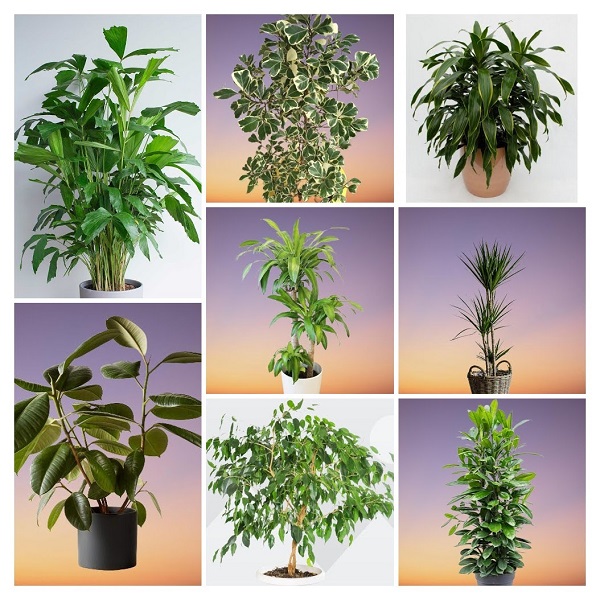
24 Best Indoor Trees to Spruce Up Your Home
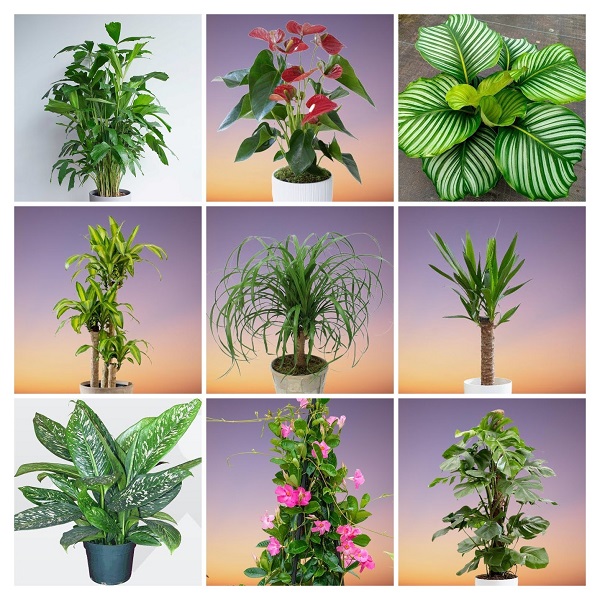
25 Best Large Low Light Plants for the Living Room

29 Low Maintenance Plants for a Sunny Balcony
Amazon Associates Disclosure
Homeplantsguide.com is a participant in the Amazon Services LLC Associates Program, an affiliate advertising program designed to provide a means for sites to earn advertising fees by advertising and linking to amazon.com.
I get commissions for purchases made through links in this post, at no cost to you.
How to Care For Travelers Palm

Table of Contents
Last Updated on October 17, 2022 by Plant Mom Care
Travelers Palm is indigenous to Madagascar and isn’t a true palm. This spectacular imposter is related to the bird of paradise and bananas.
Its two-dimensional fan of 14-feet-long leaves grows at a 45o angle from a trunk that can measure almost 12 inches in diameter and can reach a mature height of 50 feet. Young plants grow fast until the trunk emerges from the ground then growth settles down to a moderate pace.
The leaves can collect rainwater and distribute it to the plant’s stem. The young plant grows at ground level until the trunk emerges and sheds its lowest leaves, leaving behind leaf scar rings. During summer this plant produces white or yellow flowers, similar to the flowers of a bird-of-paradise. The seeds are covered in bright blue hairy fiber.

Because of its size, this plant works best when grown in expansive landscapes and gardens. It can also be grown as a young potted plant for some time and adds an interesting accent to rooms with high ceilings and large windows.
Travelers Palm Light Requirements
Young plants grow best in a shaded area while older plants love being grown under full sun. You can grow young plants indoors in containers under bright light but it eventually becomes too big and has to be transplanted outdoors.
Travelers Palm Watering
This palm prefers soil that stays consistently moist like its original habitat in rainforests but do not overwater the plant. The stems of fronds can store water so the plant can survive dry spells in warm regions.
Travelers Palm Humidity
As a tropical plant, it can grow in above-average humidity levels indoors but it will enjoy higher levels of humidity, so keep a humidifier nearby when growing it indoors.
Travelers Palm Temperature
It prefers temperatures between 50 – 80°F. If temperatures drop below 60°F, the tree will suffer from stress, and temperatures below 40°F will kill the tree. It grows well outdoors in zones 11 – 12.
Travelers Palm Soil
Rich, loamy soil along with neutral or mild acidity is best for this plant. The soil must be able to retain water without getting too soggy.
Travelers Palm Repotting
Potted plants must be repotted when roots start growing out of drainage holes or every 1 – 2 years in spring. Choose a container about 1 to 2 inches wider than the original with sufficient drainage holes.

Fill the new container to about 1/3 with potting soil, carefully lift the plant out of the container it’s currently in, remove any excess soil still attached to the roots and trim any old or dead roots. Plant the root ball in the container, add extra potting soil, and water it well.
Note: this plant should be grown in a large and heavy container as it can become top heavy and fall over. Many choose to plant it outdoors once it grows too big indoors if the climate is suitable.
Travelers Palm Propagation
The plant is propagated by division or by seeds. Separate any rooted suckers growing at the plant’s base by gently tugging them up and replanting them in individual containers with damp, well-aerated soil. There might be some roots tangled with the roots of the mother plant that you will have to carefully disentangle to avoid damage.
Keep the baby plants in a bright but shaded spot and make sure the roots of the mother plant are covered back properly with soil.
Propagation from seeds requires some more effort, time, and patience as germination is a slow process with this plant. Remove the blue hairy fringes from the seeds and soak the seeds in warm water for around 24 – 48 hours to soften the hard seed coat. Cover the container with aluminum foil to conserve warmth. Maintain a room temperature of more than 65°F and change the water every 12 hours.

Sow them in damp, sandy soil and cover them with a fine layer of soil. Keep misting the soil but do not overwater. Keep them in temperatures around 68°F.
Once the seedlings germinate usually within a month or so, continue misting them until two months old. Now they can be transplanted into individual containers filled with rich, loamy soil.
Additional Care
Use all-purpose fertilizer or a fertilizer specifically made for tropical plants to feed the plant once every 2 months during spring, summer, and autumn.
The older outer branches can be pruned as necessary, particularly if you want to control the plant’s spread indoors – it can survive with 5 – 6 leaves. Deadheading wilted blooms will prevent the plant from self-seeding.
Travelers Palm Common Problems
This palm is vulnerable to Cercospora leaf spot, a very serious disease, and root rot. While this plant is considered to be pest-resistant, spider mites might occasionally infest the plant, particularly when humidity levels are low.
Prune off infected leaves and do not overwater the plant. Isolate the plant if you spot spider mites, a spray of neem oil will help control the mites. Keep a humidifier near the plant to raise humidity levels.
Leaves might turn yellow on occasion due to overwatering or lack of nutrients. Let the 1 to 2 inches of topsoil become dry before watering it again. Feed the plant once every 2 months in spring, summer, and autumn to make sure it receives nutrients.
Brown leaves on this plant could be due to over-fertilization or overwatering and poor drainage. If you are feeding and watering the plant properly, check whether the soil is retaining water.
How quickly do Travelers’ Palms grow?
It grows rapidly, even though it initially starts as a bunch of small leaves growing out of the ground. It can grow about 3 feet a year, ultimately reaching a massive height and width. If you grow it in containers, be prepared to eventually transfer it to your garden outdoors but make sure you plant it at least 8 – 10 feet from any walls.
How tall do Travelers’ Palms grow?
They can reach a mature height of more than 50 feet.
Do Travelers’ Palms spread?
They can spread by suckers at the plant’s base and by self-seeding if you allow the flowers to grow and produce seeds.
Related Care Guides
- Kentia Palm (Howea Forsteriana)
- Parlor Palm
- Ponytail Palm
- Neanthe Bella Palm
- Majesty Palm
Plant Mom Care is a participant in the Amazon Services LLC Associates Program, an affiliate advertising program designed to provide a means for sites to earn advertising fees by advertising and linking to Amazon.com, We make a small commission when you do purchase products following our links
View prices for your travel dates
Reviews we perform checks on reviews. tripadvisor’s approach to reviews before posting, each tripadvisor review goes through an automated tracking system, which collects information, answering the following questions: how, what, where and when. if the system detects something that potentially contradicts our community guidelines , the review is not published. when the system detects a problem, a review may be automatically rejected, sent to the reviewer for validation, or manually reviewed by our team of content specialists, who work 24/7 to maintain the quality of the reviews on our site. our team checks each review posted on the site disputed by our community as not meeting our community guidelines . learn more about our review moderation..
- Excellent 6
- Very Good 11
- All languages ( 25 )
- Russian ( 25 )
- English ( 0 )
Own or manage this property? Claim your listing for free to respond to reviews, update your profile and much more.
ELEKTROSTAL HOTEL - Reviews

Turn Your Curiosity Into Discovery
Latest facts.
11 Facts About National Love Your Produce Manager Day April 2nd
10 Facts About National Clean Out Your Medicine Cabinet Day April 19th
40 facts about elektrostal.
Written by Lanette Mayes
Modified & Updated: 02 Mar 2024
Reviewed by Jessica Corbett

Elektrostal is a vibrant city located in the Moscow Oblast region of Russia. With a rich history, stunning architecture, and a thriving community, Elektrostal is a city that has much to offer. Whether you are a history buff, nature enthusiast, or simply curious about different cultures, Elektrostal is sure to captivate you.
This article will provide you with 40 fascinating facts about Elektrostal, giving you a better understanding of why this city is worth exploring. From its origins as an industrial hub to its modern-day charm, we will delve into the various aspects that make Elektrostal a unique and must-visit destination.
So, join us as we uncover the hidden treasures of Elektrostal and discover what makes this city a true gem in the heart of Russia.
Key Takeaways:
- Elektrostal, known as the “Motor City of Russia,” is a vibrant and growing city with a rich industrial history, offering diverse cultural experiences and a strong commitment to environmental sustainability.
- With its convenient location near Moscow, Elektrostal provides a picturesque landscape, vibrant nightlife, and a range of recreational activities, making it an ideal destination for residents and visitors alike.
Known as the “Motor City of Russia.”
Elektrostal, a city located in the Moscow Oblast region of Russia, earned the nickname “Motor City” due to its significant involvement in the automotive industry.
Home to the Elektrostal Metallurgical Plant.
Elektrostal is renowned for its metallurgical plant, which has been producing high-quality steel and alloys since its establishment in 1916.
Boasts a rich industrial heritage.
Elektrostal has a long history of industrial development, contributing to the growth and progress of the region.
Founded in 1916.
The city of Elektrostal was founded in 1916 as a result of the construction of the Elektrostal Metallurgical Plant.
Located approximately 50 kilometers east of Moscow.
Elektrostal is situated in close proximity to the Russian capital, making it easily accessible for both residents and visitors.
Known for its vibrant cultural scene.
Elektrostal is home to several cultural institutions, including museums, theaters, and art galleries that showcase the city’s rich artistic heritage.
A popular destination for nature lovers.
Surrounded by picturesque landscapes and forests, Elektrostal offers ample opportunities for outdoor activities such as hiking, camping, and birdwatching.
Hosts the annual Elektrostal City Day celebrations.
Every year, Elektrostal organizes festive events and activities to celebrate its founding, bringing together residents and visitors in a spirit of unity and joy.
Has a population of approximately 160,000 people.
Elektrostal is home to a diverse and vibrant community of around 160,000 residents, contributing to its dynamic atmosphere.
Boasts excellent education facilities.
The city is known for its well-established educational institutions, providing quality education to students of all ages.
A center for scientific research and innovation.
Elektrostal serves as an important hub for scientific research, particularly in the fields of metallurgy, materials science, and engineering.
Surrounded by picturesque lakes.
The city is blessed with numerous beautiful lakes, offering scenic views and recreational opportunities for locals and visitors alike.
Well-connected transportation system.
Elektrostal benefits from an efficient transportation network, including highways, railways, and public transportation options, ensuring convenient travel within and beyond the city.
Famous for its traditional Russian cuisine.
Food enthusiasts can indulge in authentic Russian dishes at numerous restaurants and cafes scattered throughout Elektrostal.
Home to notable architectural landmarks.
Elektrostal boasts impressive architecture, including the Church of the Transfiguration of the Lord and the Elektrostal Palace of Culture.
Offers a wide range of recreational facilities.
Residents and visitors can enjoy various recreational activities, such as sports complexes, swimming pools, and fitness centers, enhancing the overall quality of life.
Provides a high standard of healthcare.
Elektrostal is equipped with modern medical facilities, ensuring residents have access to quality healthcare services.
Home to the Elektrostal History Museum.
The Elektrostal History Museum showcases the city’s fascinating past through exhibitions and displays.
A hub for sports enthusiasts.
Elektrostal is passionate about sports, with numerous stadiums, arenas, and sports clubs offering opportunities for athletes and spectators.
Celebrates diverse cultural festivals.
Throughout the year, Elektrostal hosts a variety of cultural festivals, celebrating different ethnicities, traditions, and art forms.
Electric power played a significant role in its early development.
Elektrostal owes its name and initial growth to the establishment of electric power stations and the utilization of electricity in the industrial sector.
Boasts a thriving economy.
The city’s strong industrial base, coupled with its strategic location near Moscow, has contributed to Elektrostal’s prosperous economic status.
Houses the Elektrostal Drama Theater.
The Elektrostal Drama Theater is a cultural centerpiece, attracting theater enthusiasts from far and wide.
Popular destination for winter sports.
Elektrostal’s proximity to ski resorts and winter sport facilities makes it a favorite destination for skiing, snowboarding, and other winter activities.
Promotes environmental sustainability.
Elektrostal prioritizes environmental protection and sustainability, implementing initiatives to reduce pollution and preserve natural resources.
Home to renowned educational institutions.
Elektrostal is known for its prestigious schools and universities, offering a wide range of academic programs to students.
Committed to cultural preservation.
The city values its cultural heritage and takes active steps to preserve and promote traditional customs, crafts, and arts.
Hosts an annual International Film Festival.
The Elektrostal International Film Festival attracts filmmakers and cinema enthusiasts from around the world, showcasing a diverse range of films.
Encourages entrepreneurship and innovation.
Elektrostal supports aspiring entrepreneurs and fosters a culture of innovation, providing opportunities for startups and business development.
Offers a range of housing options.
Elektrostal provides diverse housing options, including apartments, houses, and residential complexes, catering to different lifestyles and budgets.
Home to notable sports teams.
Elektrostal is proud of its sports legacy, with several successful sports teams competing at regional and national levels.
Boasts a vibrant nightlife scene.
Residents and visitors can enjoy a lively nightlife in Elektrostal, with numerous bars, clubs, and entertainment venues.
Promotes cultural exchange and international relations.
Elektrostal actively engages in international partnerships, cultural exchanges, and diplomatic collaborations to foster global connections.
Surrounded by beautiful nature reserves.
Nearby nature reserves, such as the Barybino Forest and Luchinskoye Lake, offer opportunities for nature enthusiasts to explore and appreciate the region’s biodiversity.
Commemorates historical events.
The city pays tribute to significant historical events through memorials, monuments, and exhibitions, ensuring the preservation of collective memory.
Promotes sports and youth development.
Elektrostal invests in sports infrastructure and programs to encourage youth participation, health, and physical fitness.
Hosts annual cultural and artistic festivals.
Throughout the year, Elektrostal celebrates its cultural diversity through festivals dedicated to music, dance, art, and theater.
Provides a picturesque landscape for photography enthusiasts.
The city’s scenic beauty, architectural landmarks, and natural surroundings make it a paradise for photographers.
Connects to Moscow via a direct train line.
The convenient train connection between Elektrostal and Moscow makes commuting between the two cities effortless.
A city with a bright future.
Elektrostal continues to grow and develop, aiming to become a model city in terms of infrastructure, sustainability, and quality of life for its residents.
In conclusion, Elektrostal is a fascinating city with a rich history and a vibrant present. From its origins as a center of steel production to its modern-day status as a hub for education and industry, Elektrostal has plenty to offer both residents and visitors. With its beautiful parks, cultural attractions, and proximity to Moscow, there is no shortage of things to see and do in this dynamic city. Whether you’re interested in exploring its historical landmarks, enjoying outdoor activities, or immersing yourself in the local culture, Elektrostal has something for everyone. So, next time you find yourself in the Moscow region, don’t miss the opportunity to discover the hidden gems of Elektrostal.
Q: What is the population of Elektrostal?
A: As of the latest data, the population of Elektrostal is approximately XXXX.
Q: How far is Elektrostal from Moscow?
A: Elektrostal is located approximately XX kilometers away from Moscow.
Q: Are there any famous landmarks in Elektrostal?
A: Yes, Elektrostal is home to several notable landmarks, including XXXX and XXXX.
Q: What industries are prominent in Elektrostal?
A: Elektrostal is known for its steel production industry and is also a center for engineering and manufacturing.
Q: Are there any universities or educational institutions in Elektrostal?
A: Yes, Elektrostal is home to XXXX University and several other educational institutions.
Q: What are some popular outdoor activities in Elektrostal?
A: Elektrostal offers several outdoor activities, such as hiking, cycling, and picnicking in its beautiful parks.
Q: Is Elektrostal well-connected in terms of transportation?
A: Yes, Elektrostal has good transportation links, including trains and buses, making it easily accessible from nearby cities.
Q: Are there any annual events or festivals in Elektrostal?
A: Yes, Elektrostal hosts various events and festivals throughout the year, including XXXX and XXXX.
Was this page helpful?
Our commitment to delivering trustworthy and engaging content is at the heart of what we do. Each fact on our site is contributed by real users like you, bringing a wealth of diverse insights and information. To ensure the highest standards of accuracy and reliability, our dedicated editors meticulously review each submission. This process guarantees that the facts we share are not only fascinating but also credible. Trust in our commitment to quality and authenticity as you explore and learn with us.
Share this Fact:
THE 10 BEST Motels near Museum of Labor Glory, Elektrostal
Motels near museum of labor glory, property types, distance from, traveller rating, hotel class.
- Best Value Properties ranked using exclusive Tripadvisor data, including traveller ratings, confirmed availability from our partners, prices, booking popularity and location, as well as personal user preferences and recently viewed hotels.
- Traveller Ranked Highest rated hotels on Tripadvisor, based on traveller reviews.
- Distance from Museum of Labor Glory See properties located closest to the place of interest first with confirmed availability for your dates from our partners.

IMAGES
VIDEO
COMMENTS
Family: Strelitziaceae. Genus: Ravenala. Adans. Synonyms. Urania Schreb. Ravenala is a genus of monocotyledonous flowering plants. Classically, the genus was considered to include a single species, Ravenala madagascariensis from Madagascar.
Travelers Palm Care Traveler Palm Size and Growth. Horonorona, the variant most commonly cultivated, achieves an average adult height of 30 to 50' feet tall.By comparison, its largest kin, Bemavo, may achieve a height of 100' feet. The central trunk of this species can measure up to 12" inches in diameter and lacks branches.
The travelers palm flaunts giant, banana-like leaves, some up to ten feet long, forming an elegant fan shape. This tree can reach 30 feet tall and span 18 feet, growing moderately. ... The travelers palm is a native to the island of Madagascar, a place renowned for its biodiversity. Though, the tree also thrives in other regions with similar ...
This nifty looking tree is commonly referred to as the traveler's palm ( Ravenala madagascariensis ). In reality, it is not a palm at all but rather a close cousin of the bird of paradise plants (Strelitziaceae). It is endemic to Madagascar and the only member of its genus. Even more fascinating is its relationship with another uniquely ...
The plane (here perpendicular to the north-south axis) of these plants is orientated to maximize daylight absorption. Ravenala madagascariensis, commonly known as the traveller's tree, traveller's palm or East-West palm, is a species of monocotyledonous flowering plant found in Madagascar. It is not a true palm but a member of the family ...
Traveler's trees (Ravenala madagascariensis). The trunk resembles that of a palm tree and attains a height of more than 8 metres (26 feet). At the top of the tree are large banana-like leaves, with long pale petioles (leaf stalks), that are arranged in a single plane to give a fanlike appearance. The leaves are 4 to 5 metres (13 to 16 feet ...
Common names: The Travelers Palm is also known as Travelers Palm and Traveler's Tree. Family: Arecaceae Origin: It is native to Madagascar. Appearance: Young Travelers Palm has a subterranean trunk that grows underground. As the palm matures it develops a short green trunk, about 1 ft in diameter, with distinctive leaf scar rings.
The Traveler's Palm is endemic to secondary forests in Madagascar. Traveler's Palm is unique in nature and is monotypic, meaning it is the only species in its genus. Ravenala madagascariensis is a big problem in Mauritius, especially on mid-altitude (3-600 m) south and west facing slopes in and around the Black River Gorges National Park.
Traveller's Tree is a palm-like tree native to Madagascar. It can reach heights of 30'-50' feet in its native habitat. It grows in frost-free areas around the world. ... Traveller's palm love being close to bright, sunny windows 😎. Place it less than 1ft from a south-facing window to maximize the potential for growth.
The Traveler's Palm (Ravenala madagascariensis) is a distinctive and iconic plant native to Madagascar, known for its unique appearance and its reputation for providing travelers with a source of water. Despite its name, it is not a true palm, but rather belongs to the family Strelitziaceae.. One of the most fascinating features of the Traveler's Palm is the way its leaves are oriented.
Prepare the container by filling with potting soil up to 2" (5cm) from the rim of the planter. Remove the plant from its pot. Make a small hole in the soil slightly larger than the root ball either by hand or using a trowel. Insert the plant into the hole and press soil firmly around the roots and just covering the root ball.
Ravenala madagascariensis exhibits a medium growth rate, reaching heights of 40-60 feet and boasting a spread of 10-15 feet. Remarkably, the Travelers Palm Tree can withstand cold temperatures down to 30°F, making it suitable for cultivation in USDA Zones 10a (30 - 35°F) to 11 (above 40°F). While it thrives in full sun, it can also adapt ...
The maintenance of the unusual indoor plant Ravenala madagascariensis differs slightly from that of conventional palms. The Travelers palm resembles a banana tree or bird of paradise a little more. However, it gets its name from the distinctive fan-shaped leaf that grows naturally in an east-west orientation, making it useful for travelers to recognize which
traveller's palm. A palm-like, evergreen tree eventually reaching up to 10m tall with an unbranched trunk topped with a fan-shaped crown of dark green leaves arranged in a single plane. The leaves are long-stalked, 3-6m long and have expaned, cup-shaped leaf bases. White-petaled flowers appear in summer from groups of boat-shaped spathes that ...
Travelers Palm (Ravenala Madagascans) is a fascinating and exotic plant known for its unique appearance and tropical allure.
ra-VEN-ah-la mad-uh-gas-KAR-ee-EN-sis. Description. Traveller's Tree is a palm-like tree native to Madagascar. It can reach heights of 30'-50' feet in its native habitat. It grows in frost-free areas around the world. Plant in rich, moist well-drained loam in the full sun. In areas where it may not be winter hardy, it can be grown in a greenhouse.
General Information. Scientific name: Ravenala madagascariensis Pronunciation: rav-eh-NAY-luh mad-uh-gas-kar-ee-EN-sis Common name(s): travelers-tree Family: Strelitziaceae USDA hardiness zones: 10A through 11 (Figure 2) Origin: native to Madagascar UF/IFAS Invasive Assessment Status: not assessed/incomplete assessment Uses: deck or patio; specimen; container or planter
Ravenala madagascariensis (Traveller's Palm) is native Madagascar where it is found growing in humid lowland forests, montane forests, grassland or rocky areas 1500 metres above sea level. Toxicity. Traveller's Palm is toxic to humans and pets. If ingested, it can cause digistive upset and other side effects. Keep the plant away from children ...
Last Updated on October 17, 2022 by Plant Mom Care. Travelers Palm is indigenous to Madagascar and isn't a true palm. This spectacular imposter is related to the bird of paradise and bananas. Its two-dimensional fan of 14-feet-long leaves grows at a 45o angle from a trunk that can measure almost 12 inches in diameter and can reach a mature height of 50 feet.
Elektrostal Hotel. 25 reviews. #1 of 2 small hotels in Elektrostal. Raskovoi st., 6, Elektrostal 144000 Russia. Write a review. Check availability. View all photos ( 44)
40 Facts About Elektrostal. Elektrostal is a vibrant city located in the Moscow Oblast region of Russia. With a rich history, stunning architecture, and a thriving community, Elektrostal is a city that has much to offer. Whether you are a history buff, nature enthusiast, or simply curious about different cultures, Elektrostal is sure to ...
Herbaceous shrub from Strelitziaceae (Bird of Paradise) family with palm-like appearance. Not a true palm, but more closely related to bananas. Reaches up to 30m height in the wild, but typically shorter in cultivation. Crown symmetrical, fan-shaped. Trunk woody-like with characteristic leaf-scar rings, hidden underground in juvenile plants ...
Motels near Museum of Labor Glory, Elektrostal on Tripadvisor: Find 1,358 traveller reviews, 1,945 candid photos, and prices for motels near Museum of Labor Glory in Elektrostal, Russia.